VANUATU is a small island country to the east of New Guinea and northeast of New Caledonia, with 340,000 inhabitants and 138 indigenous languages, plus those of its former colonisers — English and French — and a creole language derived from nineteenth-century pidjin English called Bislama. All three are official languages of Vanuatu.
Many of the beaches are fabulous, with white and pink coral sands, though in the capital, Port Vila, where I arrived, most of the freely accessible beaches are rocky, like this one.
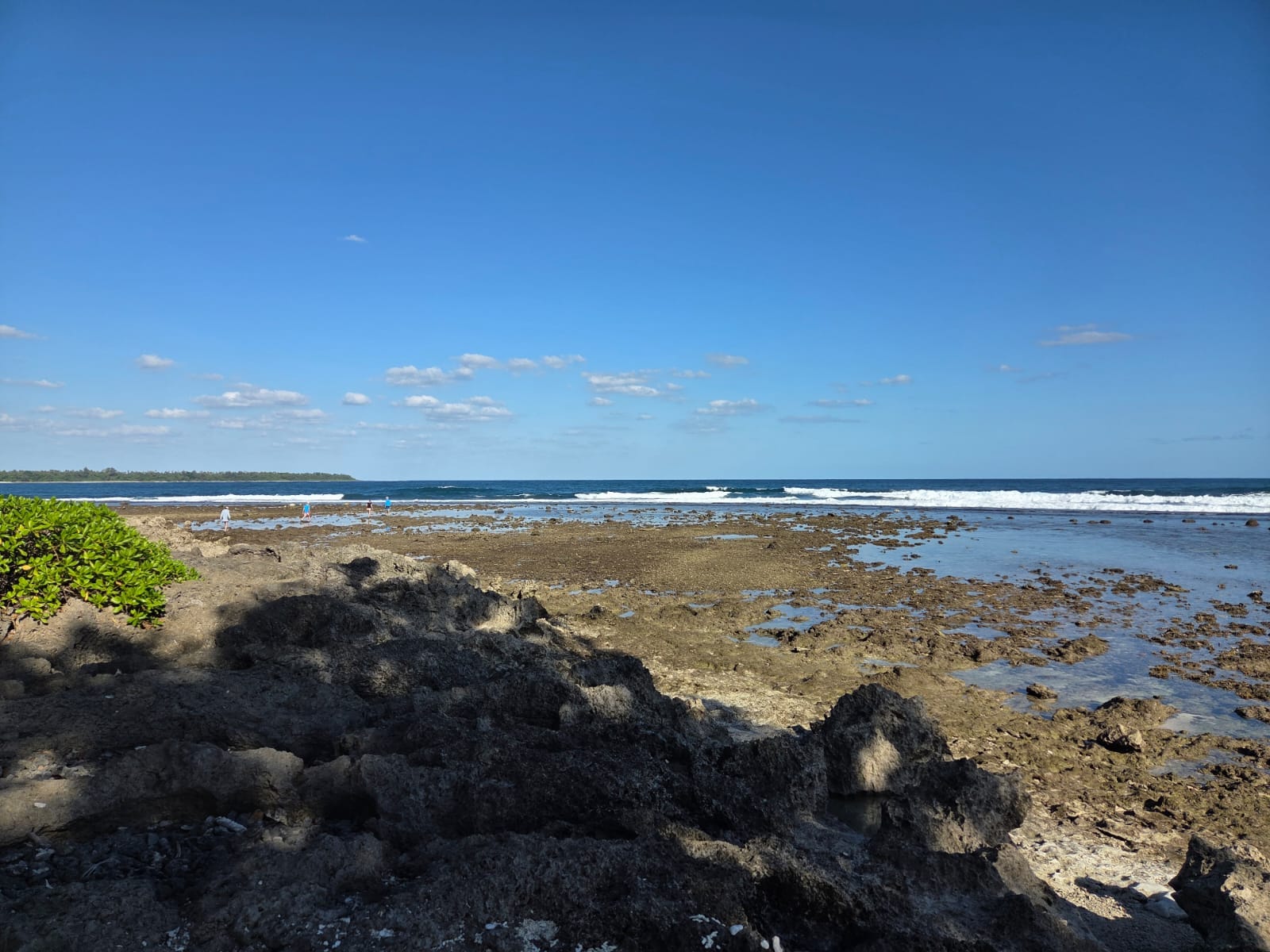
That’s a notorious peculiarity of the place. There are a few beaches that do have plenty of sand, but you have to pay a fee to walk on them. I wonder whether they have been created artificially, by sand-dredging? If so, that would explain the fee.
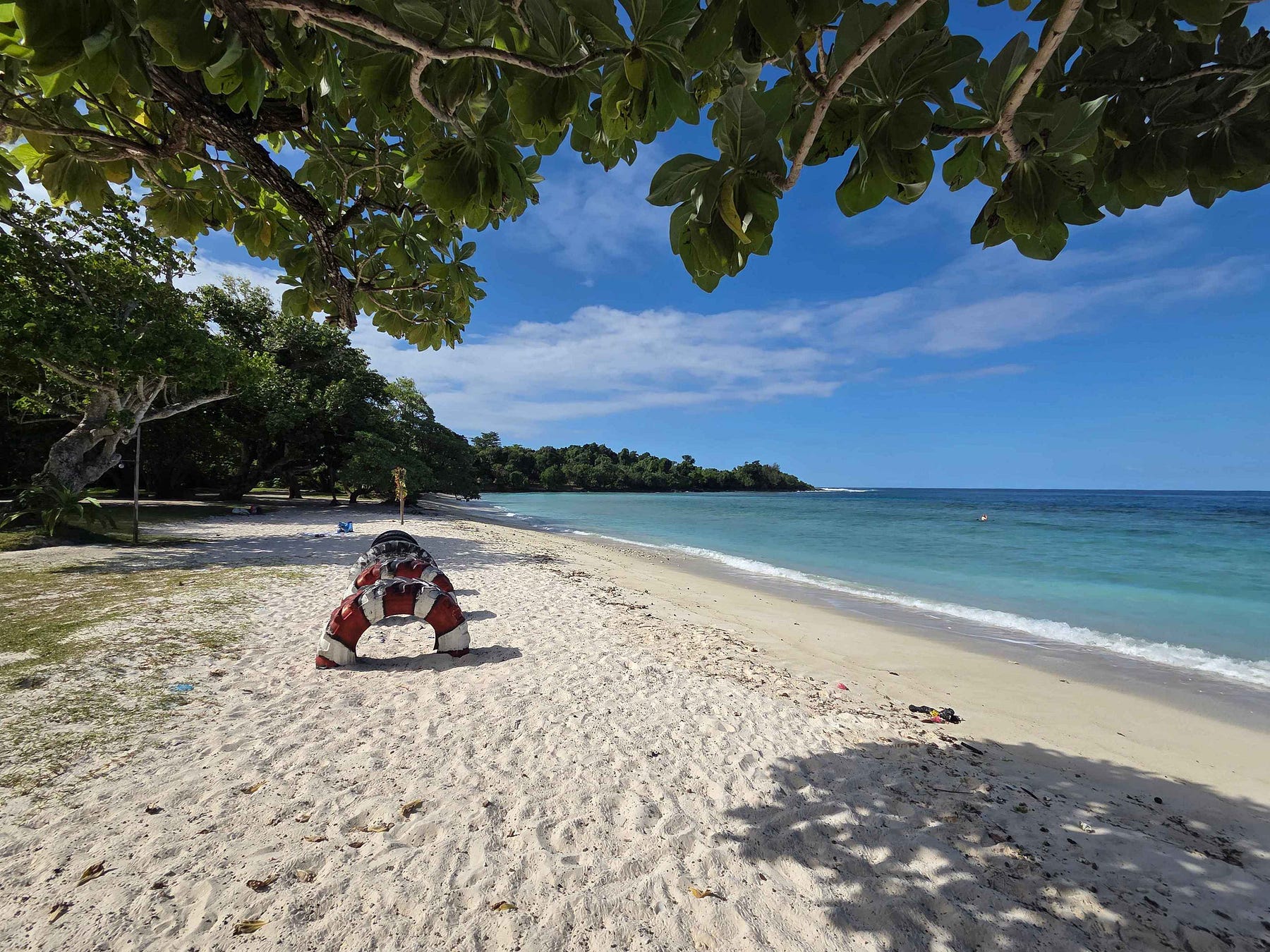
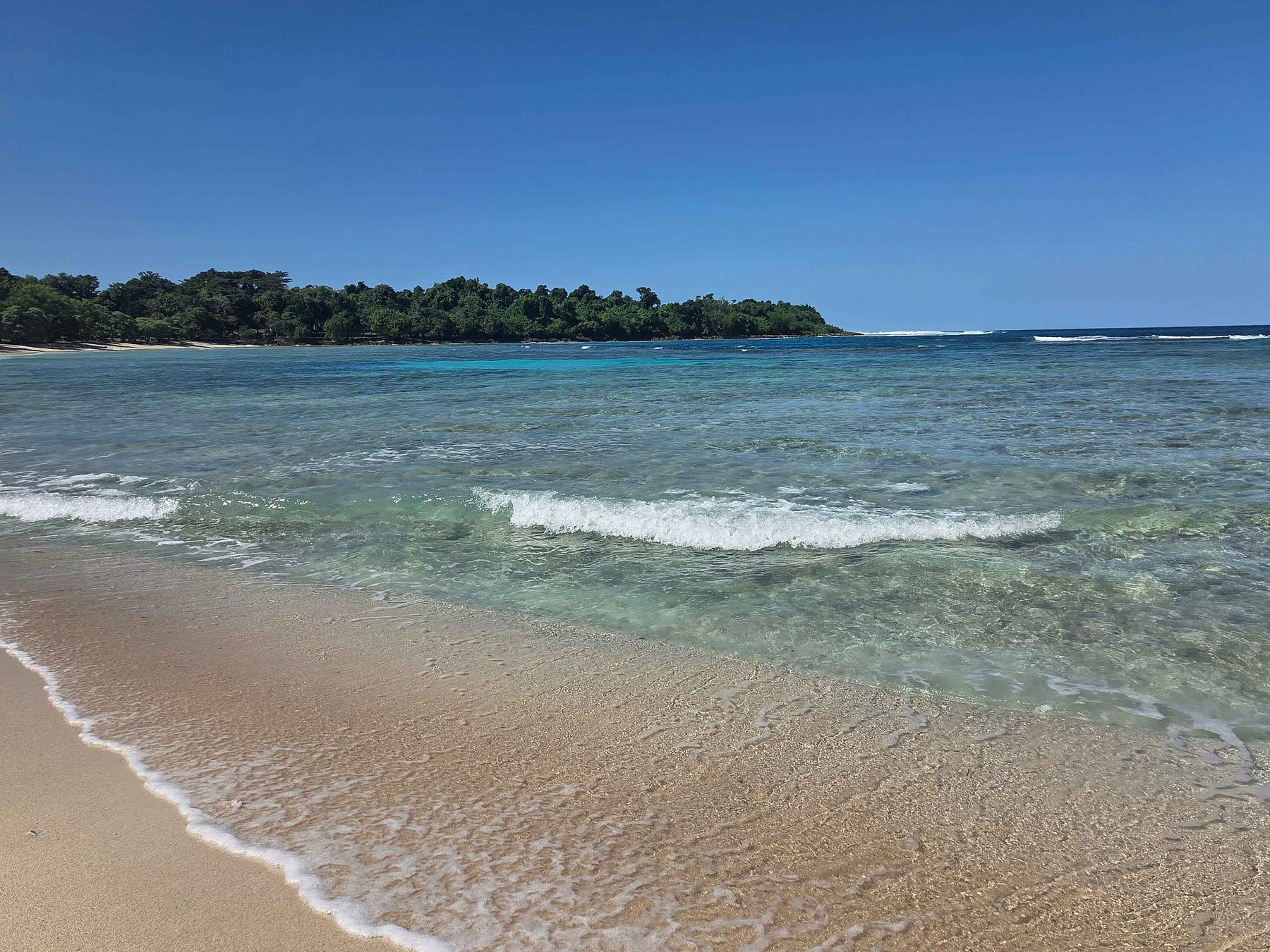
I filmed a video at Honeymoon Beach, well suited to honeymooners!
Here’s a trilingual sign in English, French, and Bislama, telling people they have to pay to go onto one of the sandy beaches.
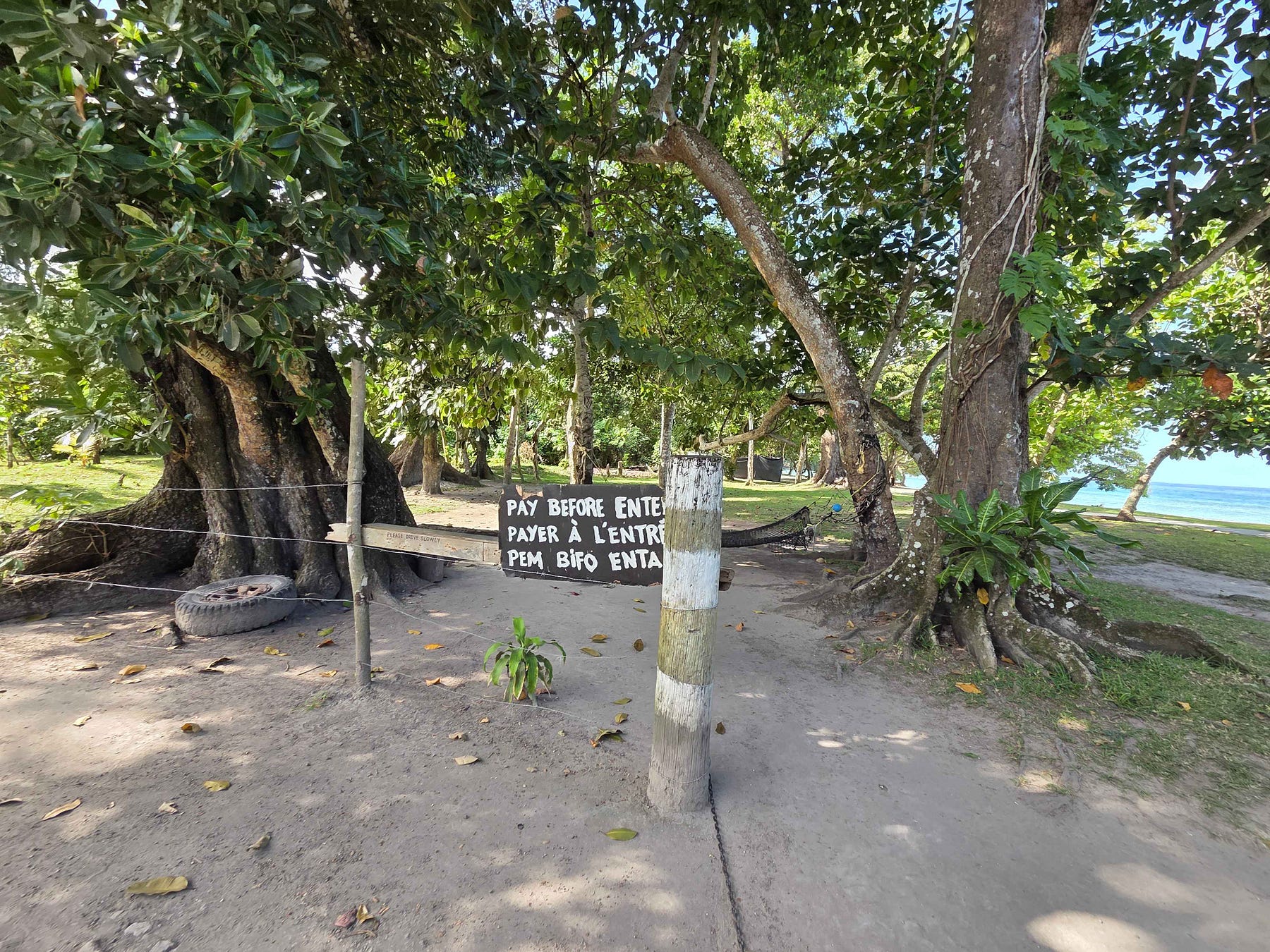
The Bislama line Pem, which comes from ‘pay him’ I suppose, Bifo Enta, shows how most Bislama words look like English words spelled phonetically.
On the other hand, the grammar comes from local languages, so the meaning of anything much longer than Pem Bifo Enta won’t be obvious to anyone who only speaks English.
Vanuatu used to be known as the New Hebrides. It was given that name by Captain Cook, who thought that this chain of islands reminded him of the Hebrides islands, to the west of the Scottish mainland.
The New Hebrides were ruled jointly from 1906, until their independence as Vanuatu in 1980, by the British and the French. This system was called the Anglo-French Condominium, or, to its skeptics, Pandemonium.
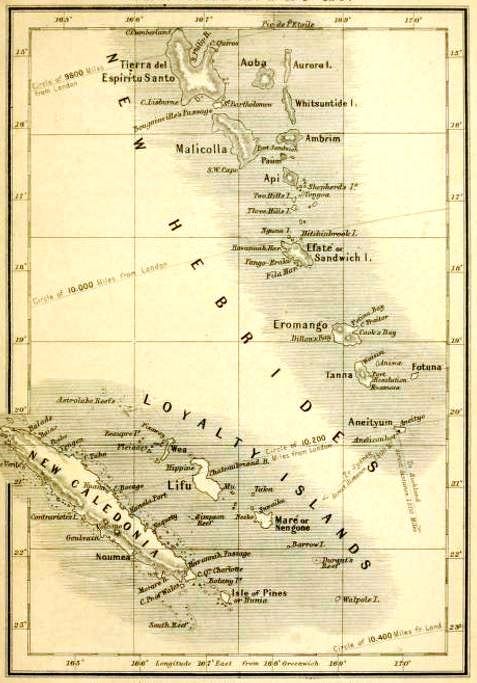
Vanuatu’s current population of 340,000 is nearly three times what it was at the time of independence. It seems to have been only about 40 or 50 thousand when the Condominium was set up.
The capital city is Port Vila, located on the central island of Efaté (“or Sandwich I.” though I don’t think anyone uses that name today), almost touching the curve of 10,000 miles from London in the old colonial map above.
The indigenous inhabitants, who make up about 98.5% of the population, are Melanesian, but their 138 indigenous languages are all of the Oceanic family, meaning that they are related to Polynesian languages such as Māori, Sāmoan, and Fijian.
This is because the very first people to settle Vanuatu were the Lapita people, ancestors of the Polynesians, around 1,200 or 1,300 BCE.
Ancestral Melanesian settlers from New Guinea, and perhaps from Australia, came later, around 500 CE, and soon outnumbered the Lapita. But they adopted the Lapitan’s Oceanic language, which gradually split up into the 138 local varieties of today.
A huge number of local languages seems to be a feature of Melanesia. It’s quite different from the situation in Polynesia where, for instance, everyone in Sāmoa just speaks Sāmoan and that’s that.
Vanuata was hit by a huge earthquake on 17 December 2024, something that happens regularly as a result of being on the Pacific Ring of Fire.
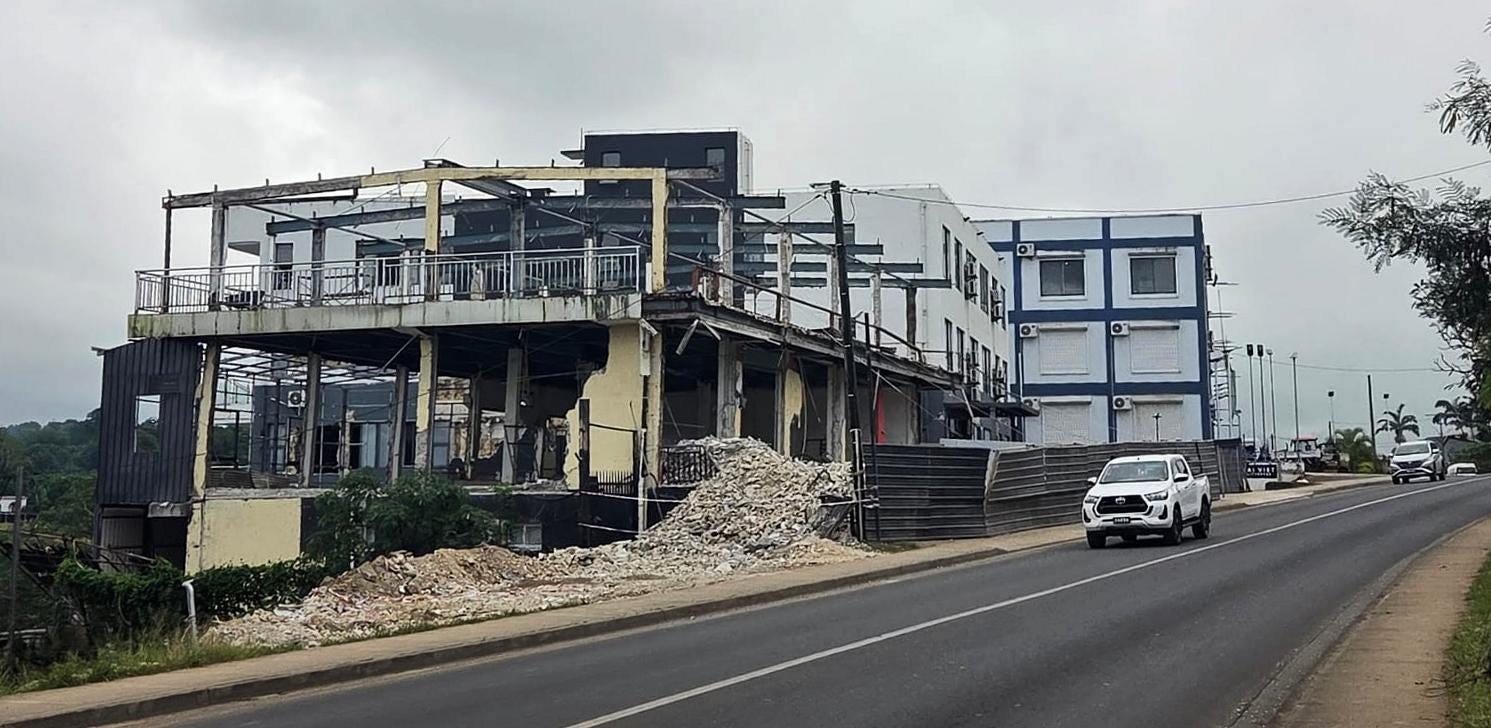
And by a devastating category-5 cyclone called Pam in 2015, as a result of being in the tropics. Vanuatu also gets hit by two or three smaller cyclones each year. It’s said to be one of the most disaster-prone countries in the world.
The Australian Foreign Affairs Minister said that Vanuatu was family, so Australia would be paying for much of the earthquake rebuild.
The immigration office no longer exists, and there is hardly any tourism right now, which is a real pity because tourism used to be a big earner for the country. And because it is a beautiful country, as tropical island nations tend to be!
There are a lot more people than when I was there last. And perhaps because of the earthquake, cyclone, and tourism recession, they seem to be poorer as well.
It certainly is expensive, and that is what a lot of people have also been complaining about. But you can get some quite good deals on Booking dot com. For instance, I got my own room for NZ $70 a night.
The first place I stayed at was called the Retreat Seaside Resort Bar & Restaurant.
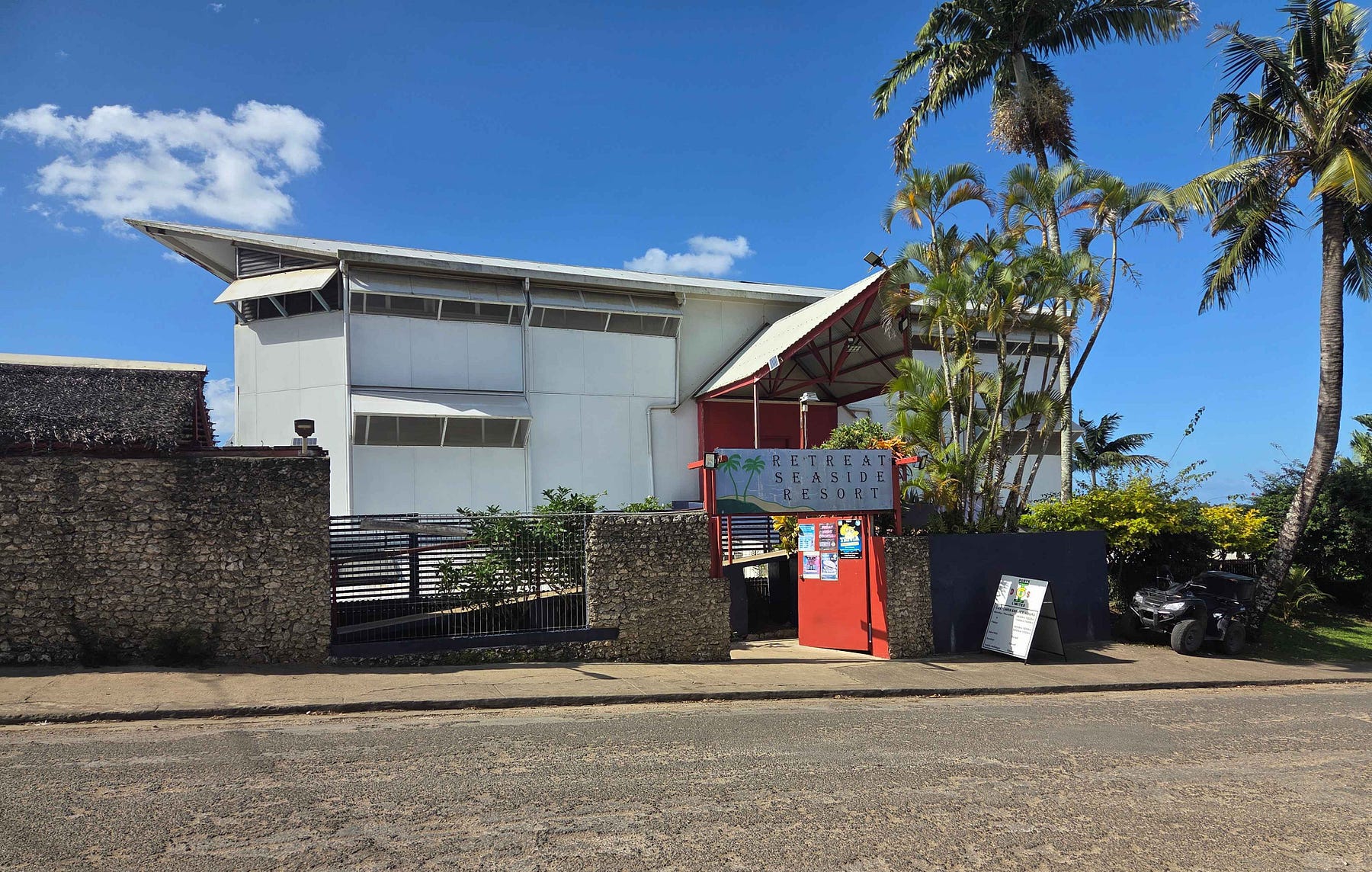
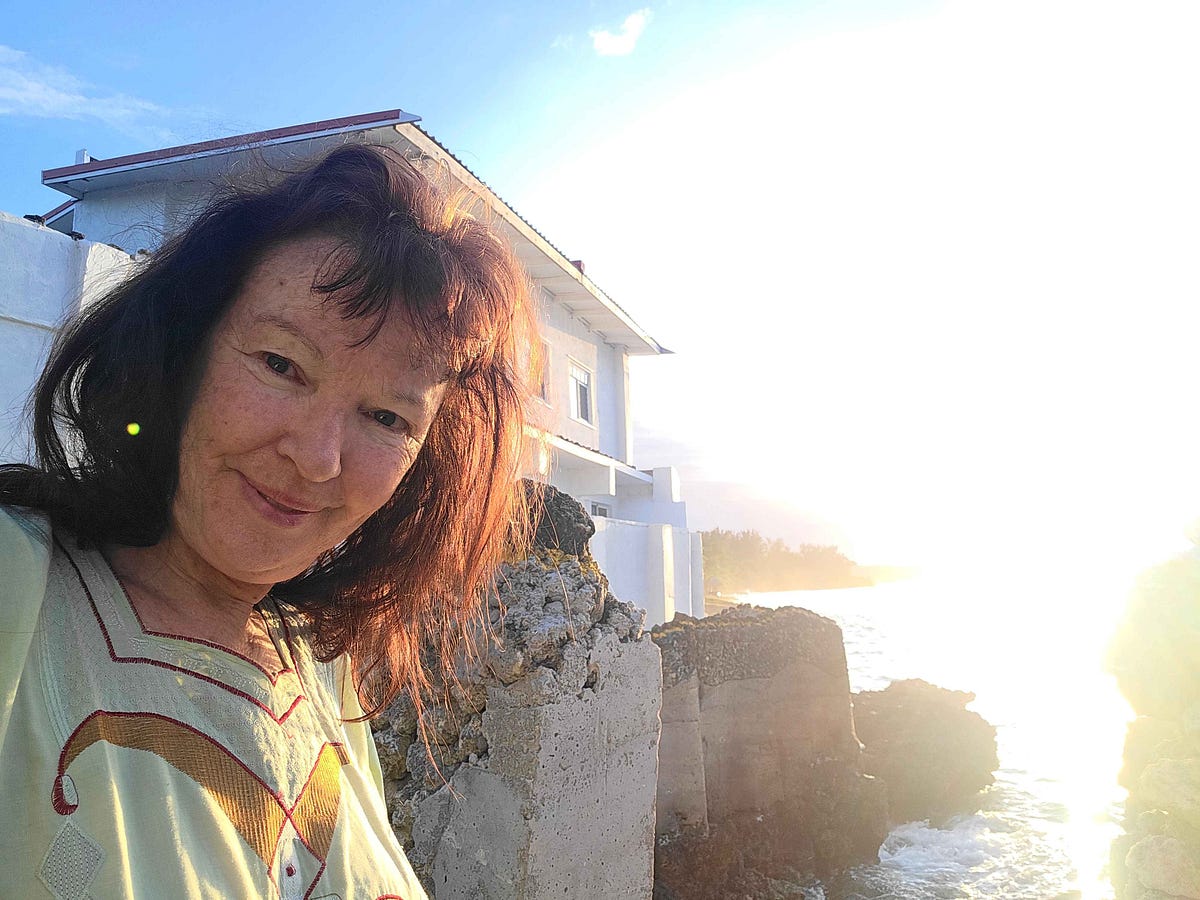
And the second was called Bluepango Guest House, which had a pool and where I had my own kitchen as well as a balcony. Without a kitchen, you could easily spend NZ $100 a day on takeouts. At those prices, you might as well stay at a package-tour resort with everything included!
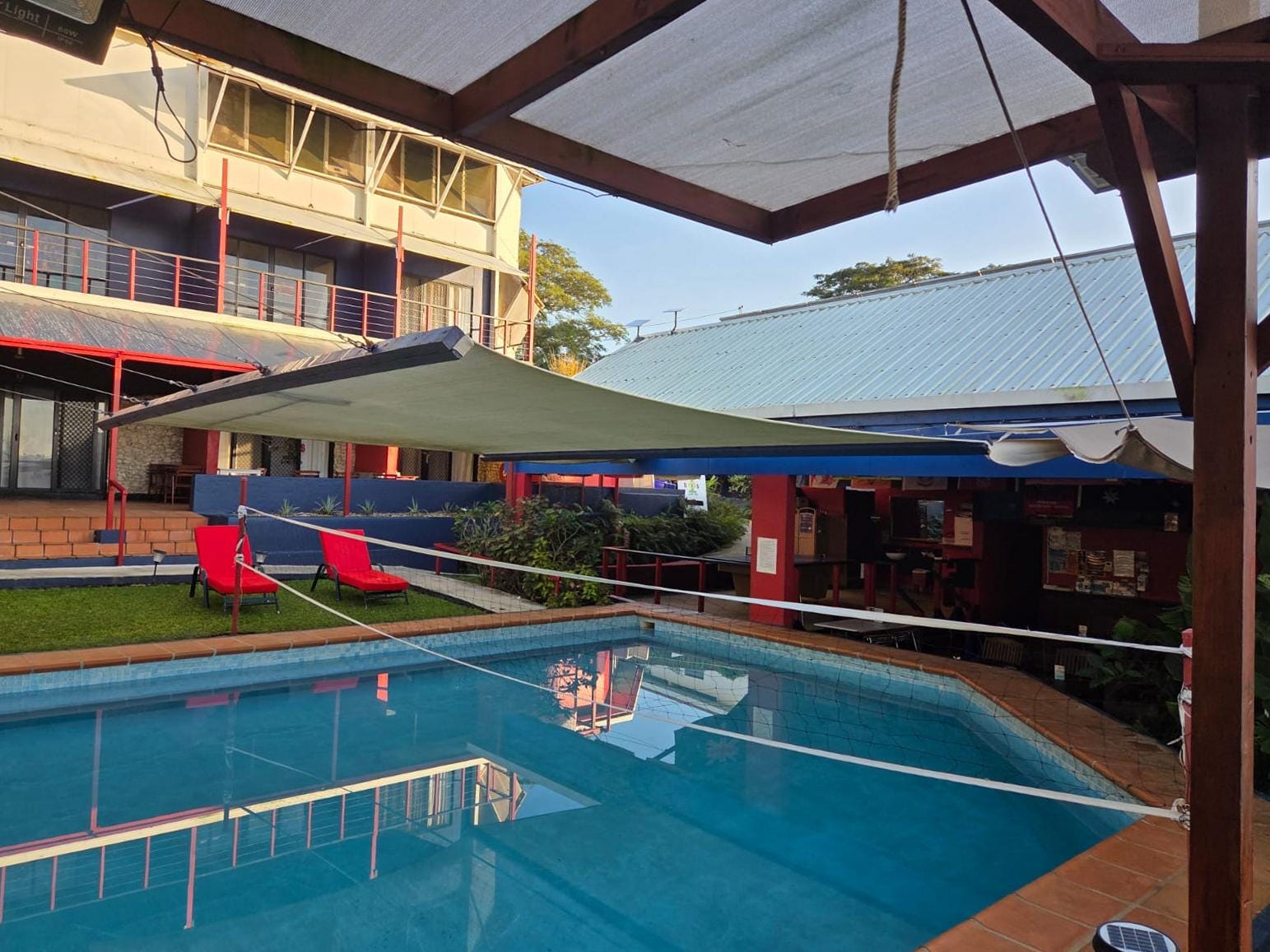
Bluepango also had excellent views, even though it was a bit further out of town than the Retreat.
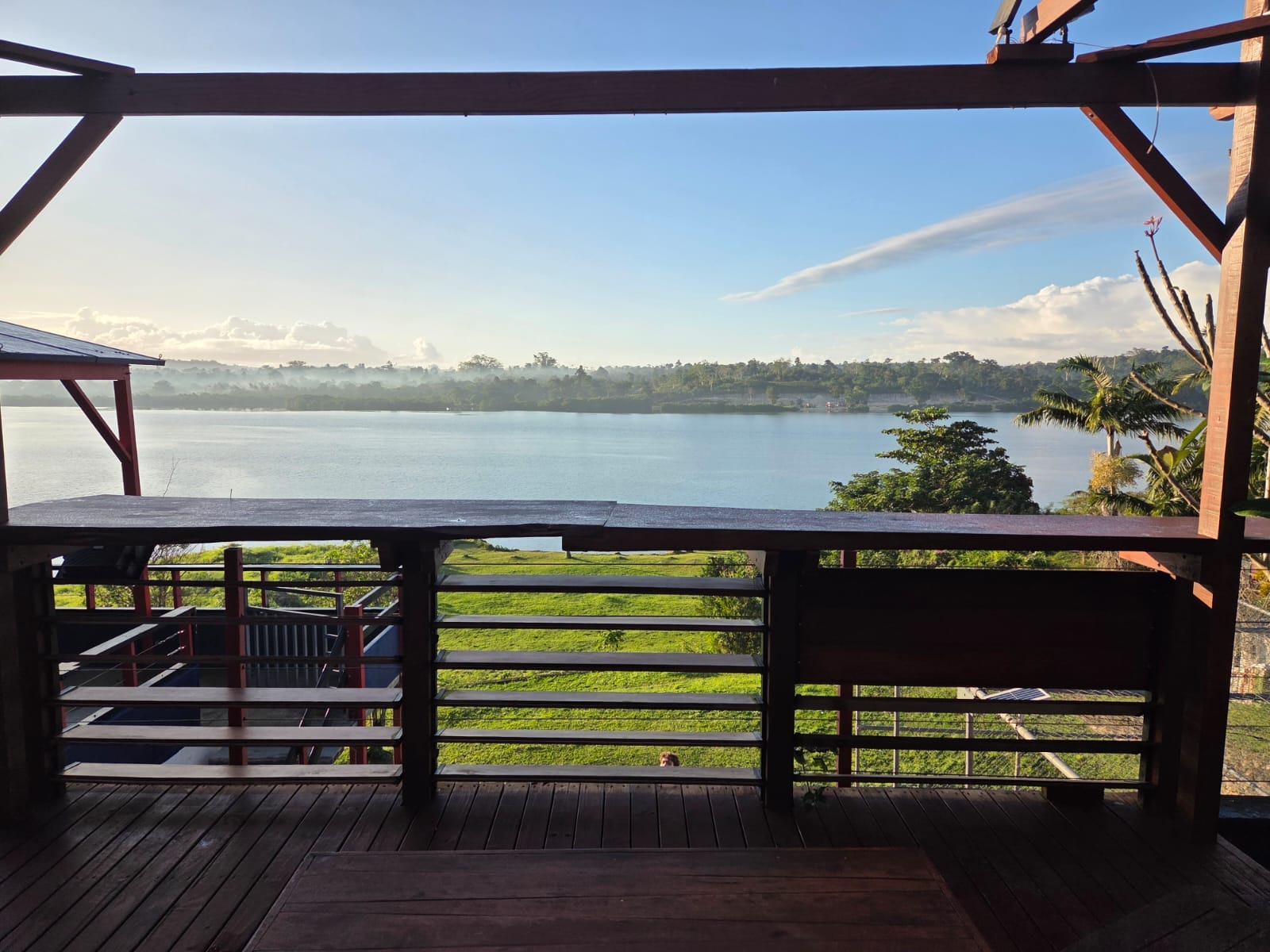
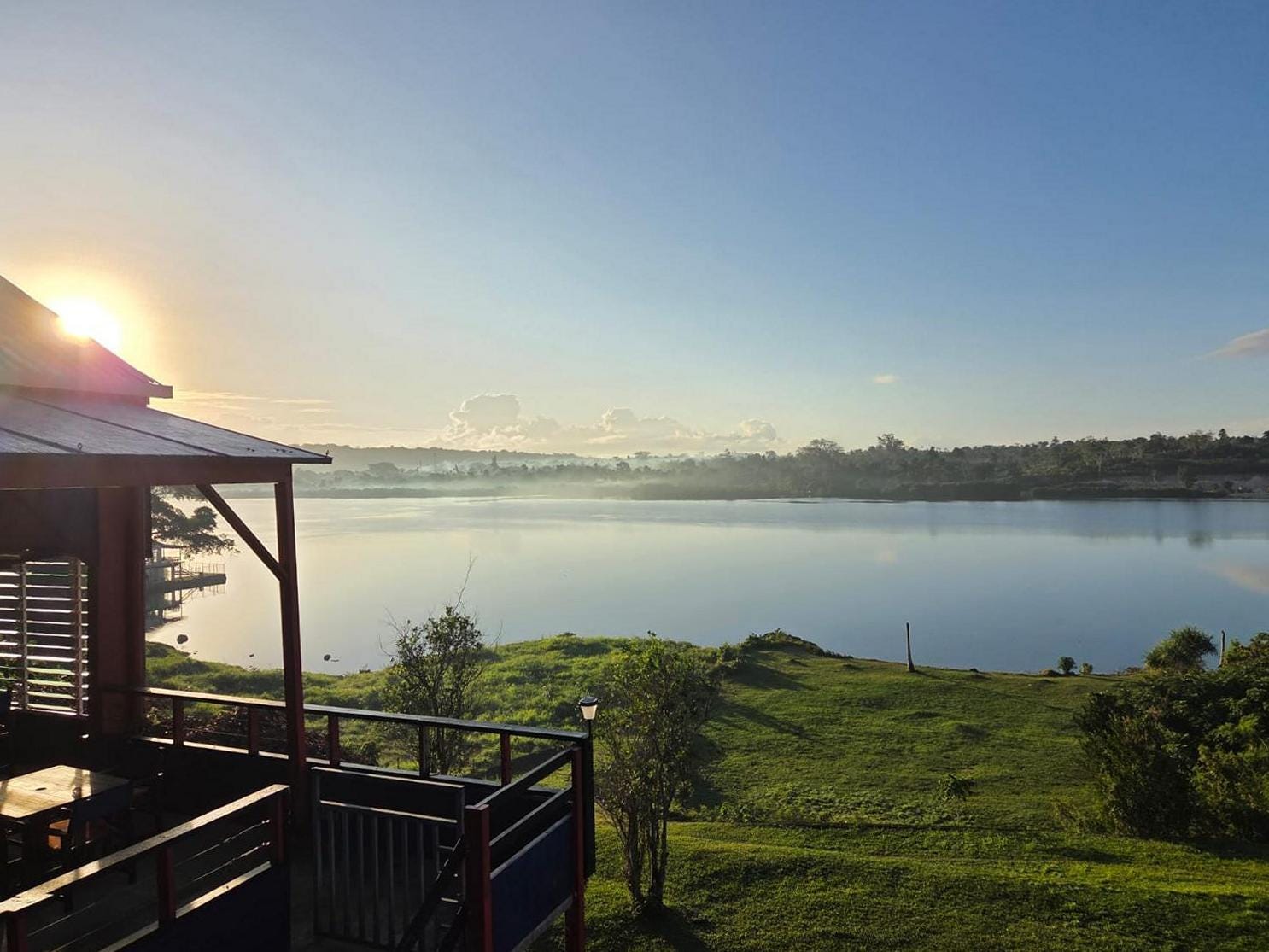
Another nice place to stay, cheaply and close to town, would be A Room with a View & Apartment Style, which I took this photo of.
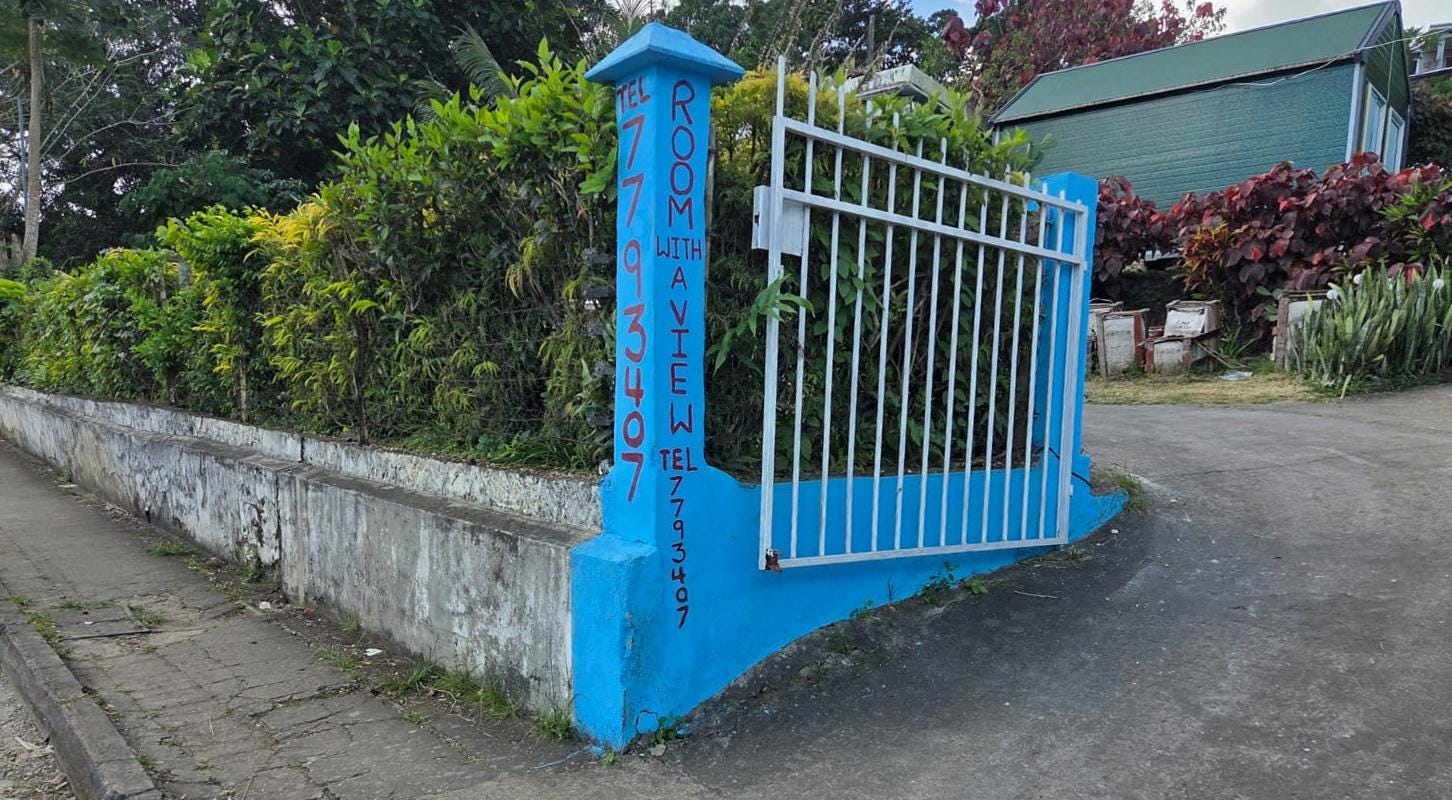
Up there would be excellent if you were just going to be in Port Vila for just a few days and did not want to stay at a resort.
Just about all of these places have great views of the harbour, either beacause they are directly on it or up on a hill, like A Room with a View.
Unfortunately, the beaches just in front of the two places where I stayed in Part Vila places were not swimmable, though the one in front of the Retreat certainly had an amazing sunrise, captured at the start of the following video (which then goes on to show scenes of customary fishing and a strange sea creature.)
Instead, you had to pay to visit the good beaches, as per the sign right at the start!
68,800 Vanuatu Vatu, the local currency, are worth NZ $1,000. The symbol for the Vanuatu Vatu on international exchanges is VUV, and on local pricetags, VT.
You can get around Port Vila on the bus for the local equivalent of NZ $1.50. They also have public eBikes.
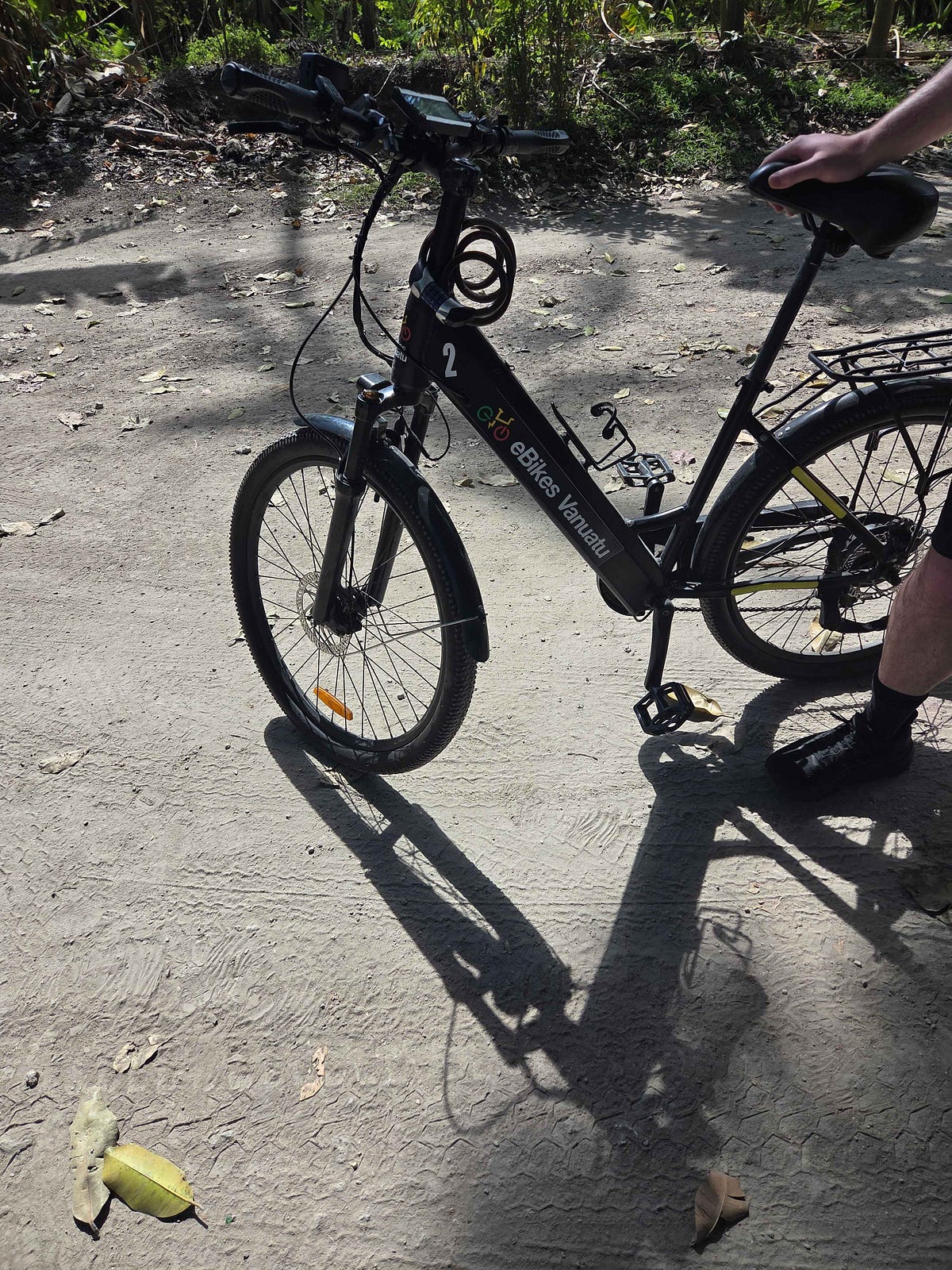
Typical fees for entry to sandy beaches are VT 500, though Club Hippique charges VT 1,000.
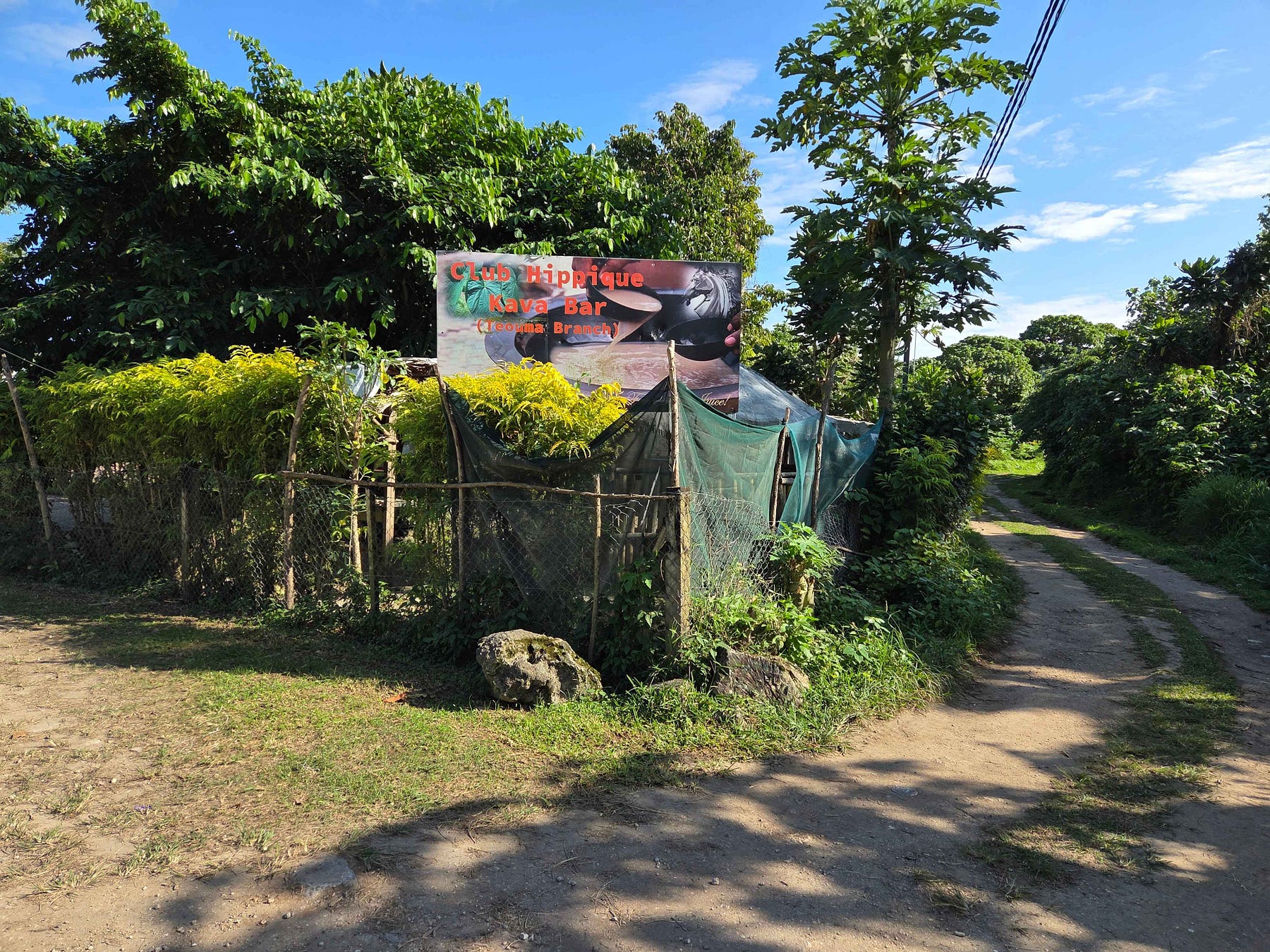
These do not include organised snorkelling or other activities, just beach access.
Tours around Efaté, also spelt Efate (without the French-style accent), typically cost around NZ $200 each, and take you all round the island.
The Chinese built the parliament in 1999, and a presidential palace more recently. Both were damaged in the 2024 earthquake, with China announcing lately that it will fund the rebuilding.
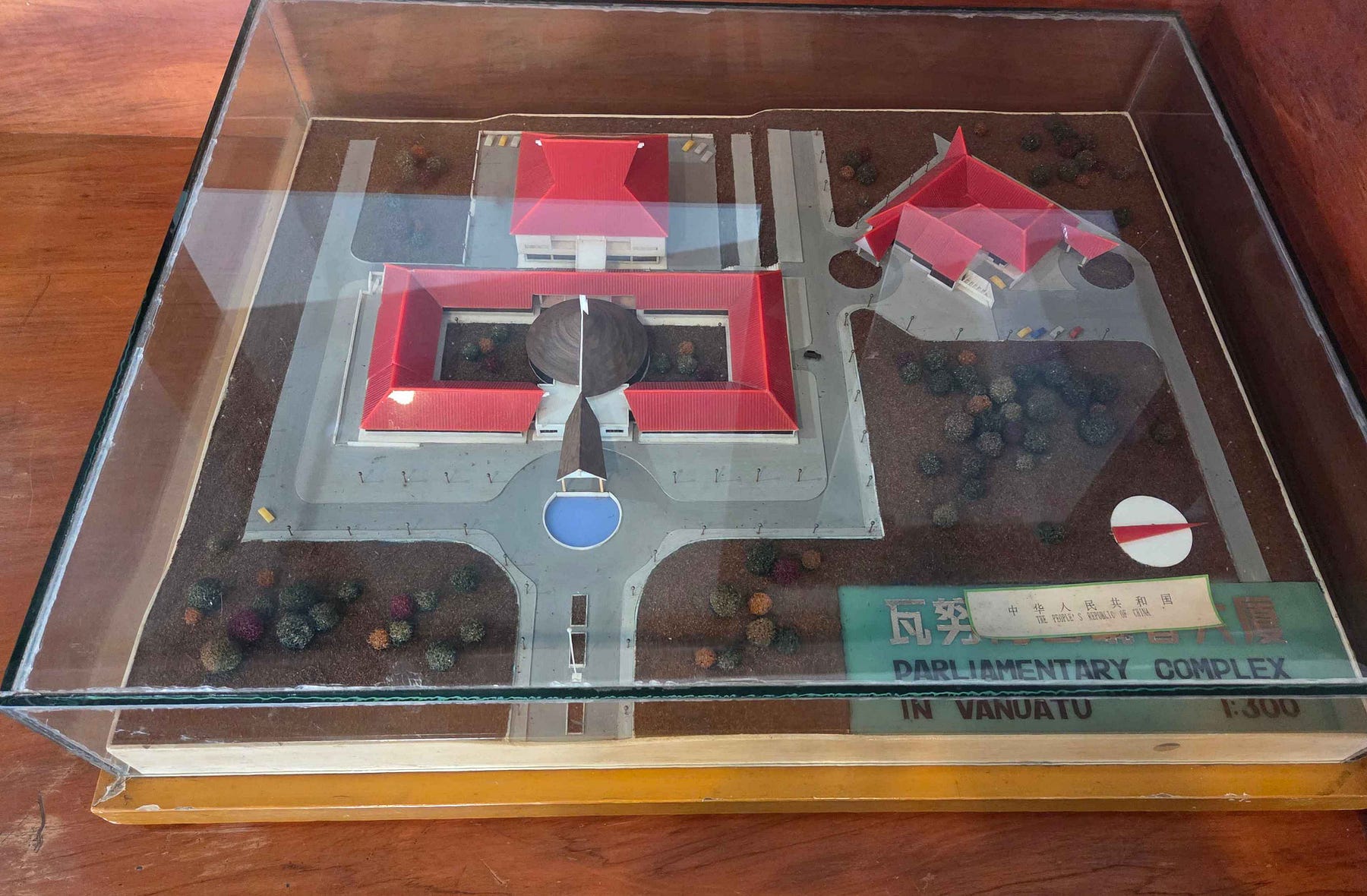
Because of the damage, i wasn’t able to go inside and visit the parliamentary library, which I had wanted to do otherwise.
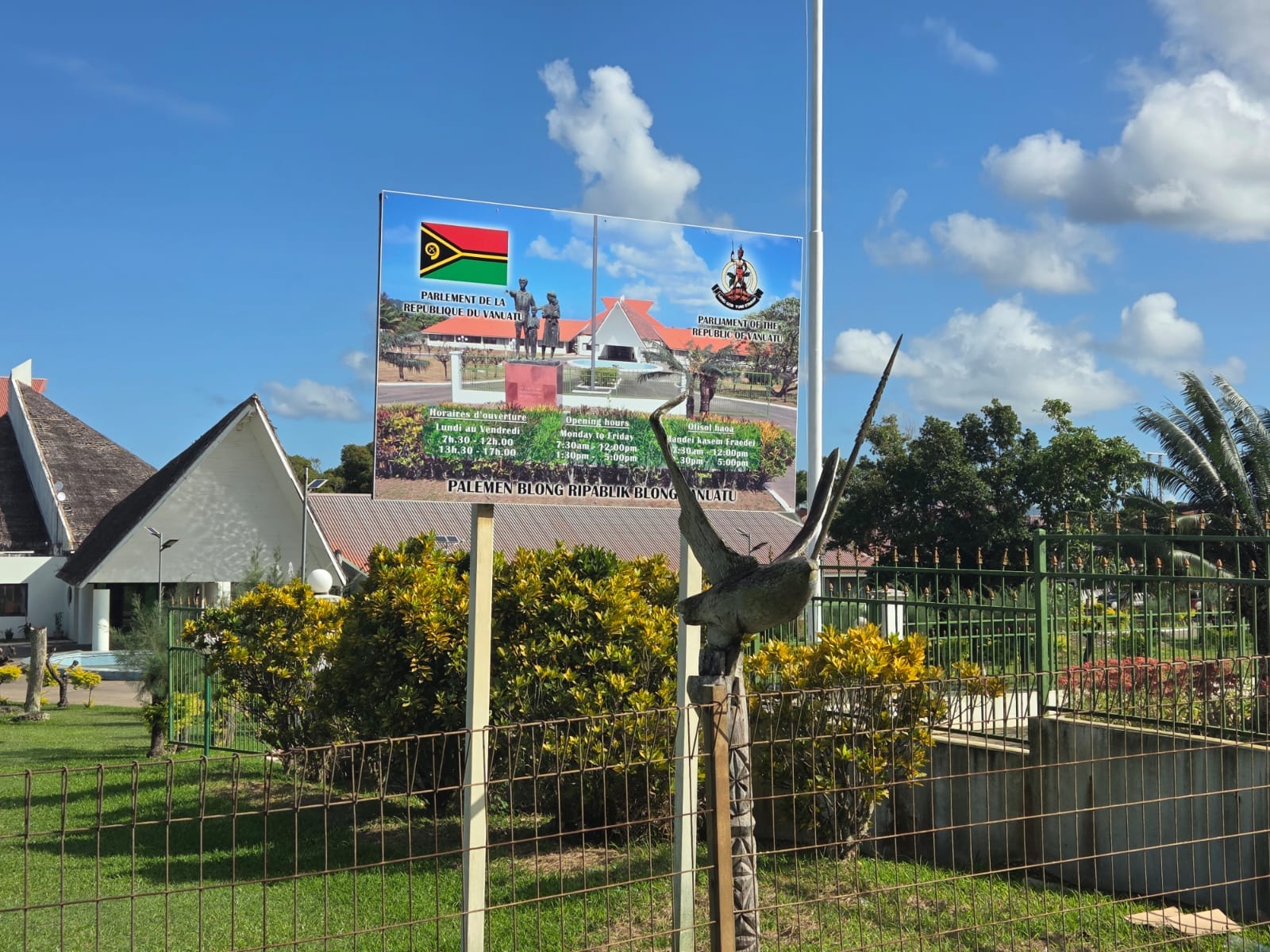
There is also a small Chinese community, which first began to settle in the 1800s.
Under Vanuatu’s post-independence constitution, the land must remain with the country’s indigenous inhabitants, known as the Ni-Vanuatu, and their descendants. The 1.5% of the population who are not Ni-Vanuatu cannot own land directly.
Ni-Vanuatu families each have a patch of land on which they grow vegetables and coconuts, and are largely self-sufficient.
I did make my way to the Malvatu Mauri (Great Council of Chiefs) nakamal, or traditional meeting-hall, and its grounds, akin to a Māori marae. It is only open sometimes.
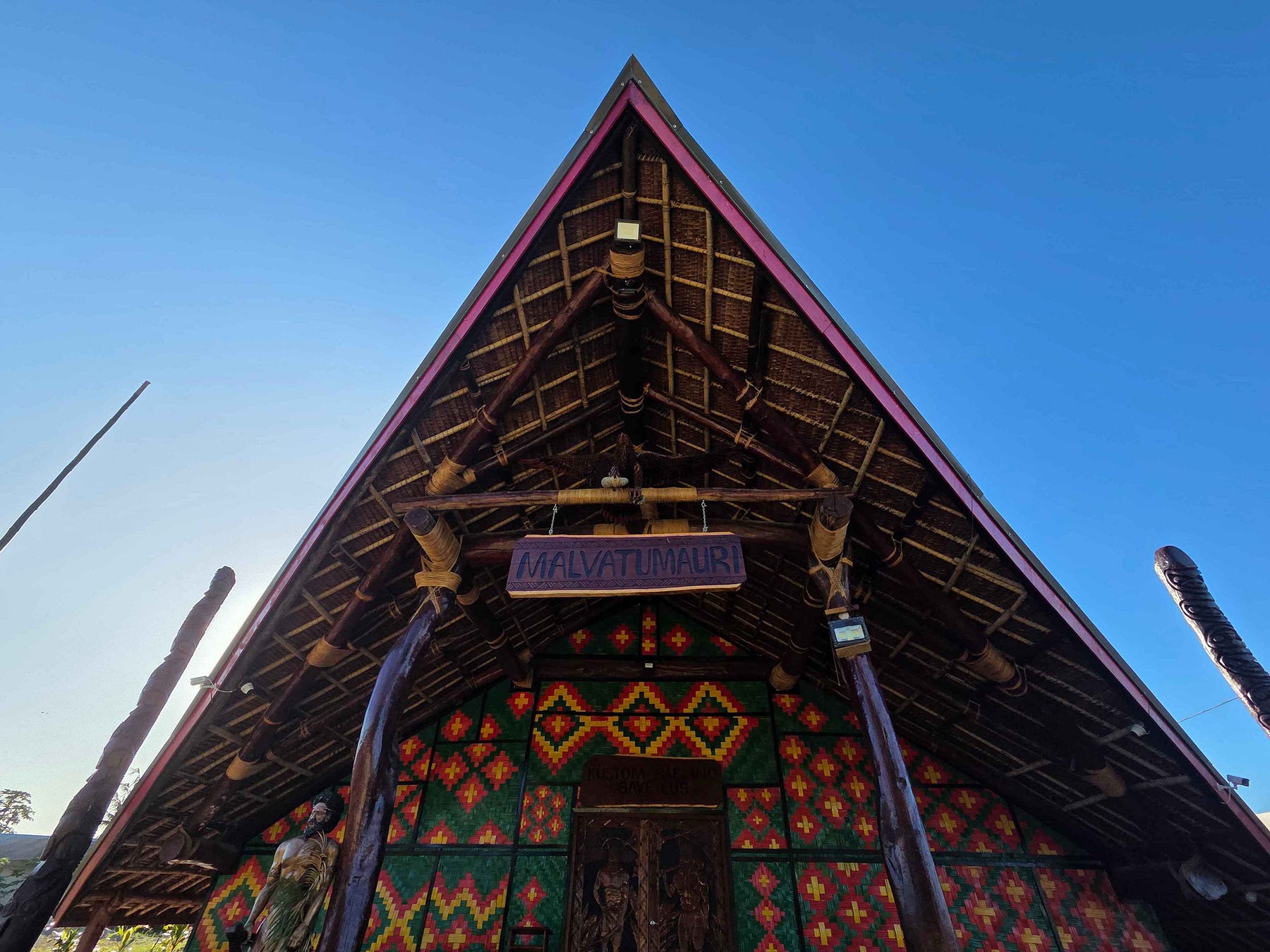
Apparently, Mal means chief, Vatu a rock, place, or island, and Mauri the life force (just as it does in Māori).
Pig sacrifices have great significance here, and in Melanesian culture more generally. Pigs’ blood flows down the little crevice in front of the nakamal when the pigs are sacrificed.
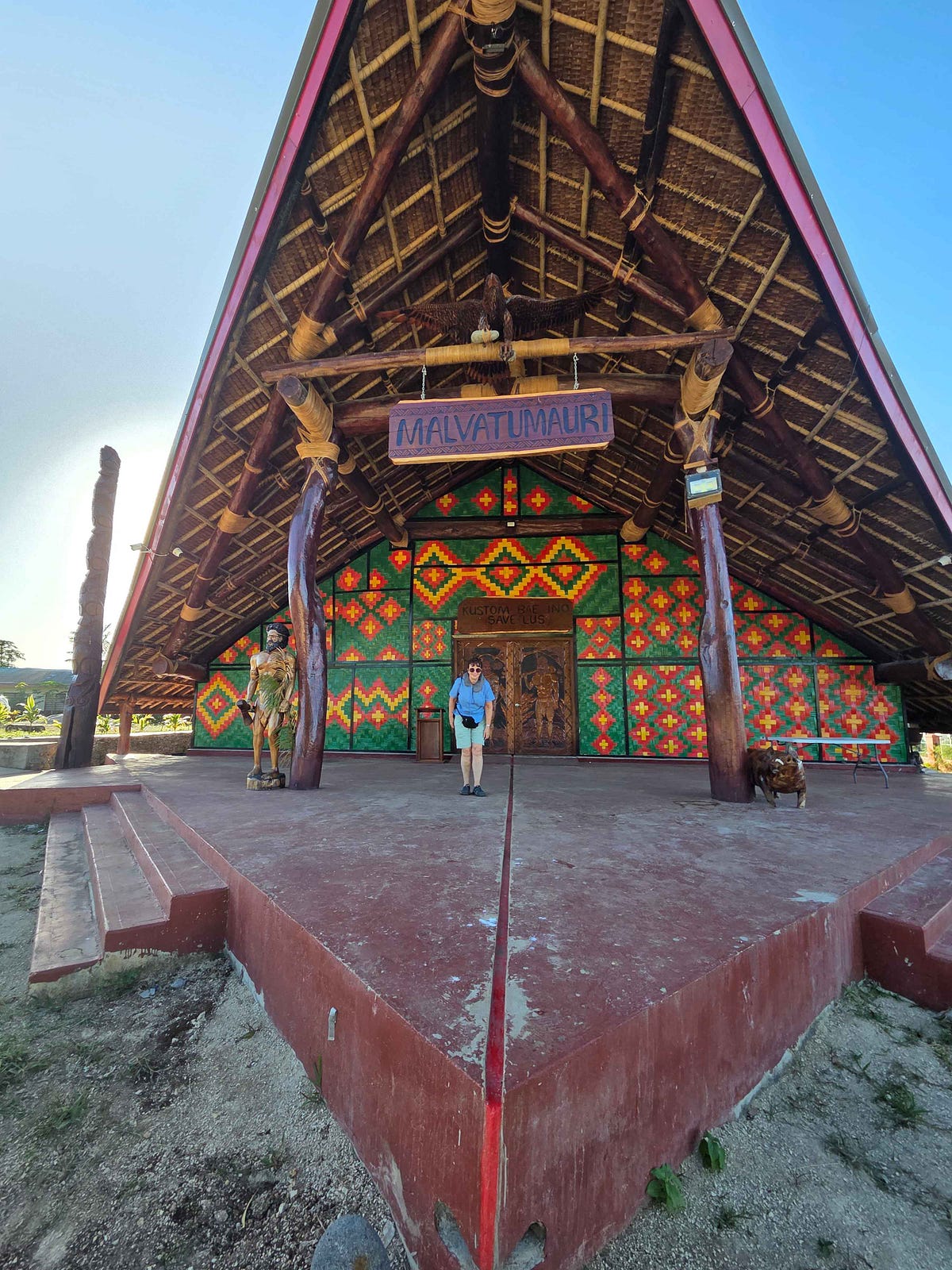
The first time I visited, it was closed. Then it was open, but I wasn’t allowed in while wearing shorts. On my third visit I wore a dress, and finally got inside.
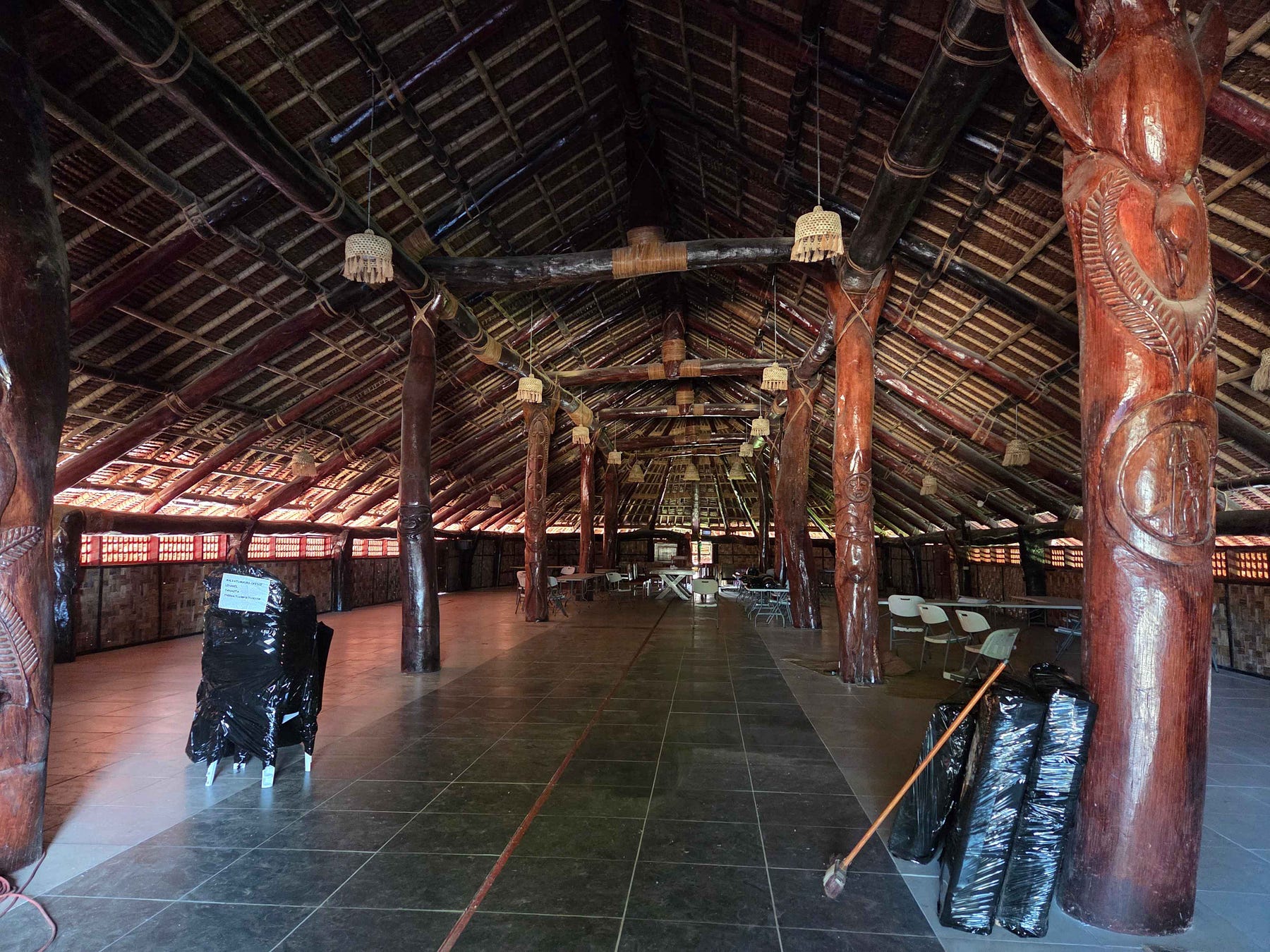
The structure has just recently been reopened, in March 2025, after it burned down two years ago. I was told by Chief George, from the island of Ambrym, who kindly showed me around, that each pole on the outside represents a former president, while each pole on the inside represents one of the islands of Vanuatu.
There was also a sign that said Vanuatu will never be free until West Papua and Kanaky are free, of the Indonesians and the French, respectively.
The Great Council of Chiefs, which is provided for in the Vanuatu Constitution as an advisory body, wants to have more than a purely advisory role and to be more like an upper house of parliament; an issue that was raised in the context of the nakamal’s reopening.
I noticed that New Zealand construction companies are working in Vanuatu, no doubt helping with the rebuild alongside the Australians, Chinese, and others.
(Apparently, the Australian workers who are helping out with reconstruction pay no tax if they are working on projects organised by the Australian government; yet another example of how Australian workers get a better deal than Kiwi ones these days, it would seem.)
Regarding places to eat out, well there are heaps, but one or two that caught my eye included the Waterfront Bar and Grill, which is down at the yacht club: that looked really nice.
And another place to eat was the Stonegrill Restaurant, which serves its food in a traditional style, on a really hot stone, and which advertises itself as having free wifi. Getting good wifi is a bit of an issue in Port Vila, I discovered, though the earthquake damage may have had something to do with it.
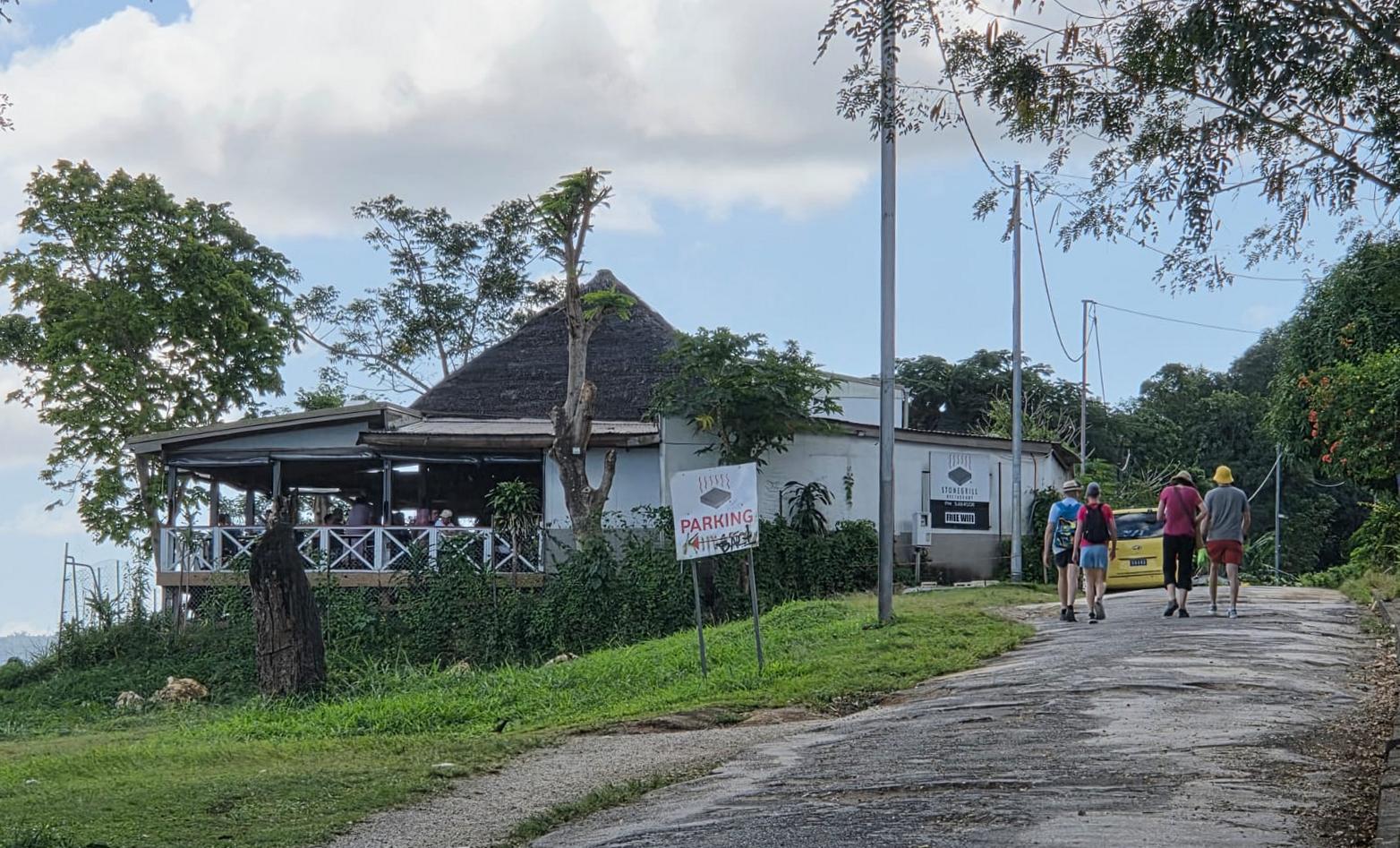
I saw quite a few people fishing along the waterfront as well.
The Port Vila markets have changed a bit since I was there last. I took photos of a market just opposite my hotel and also of a market in Mele.
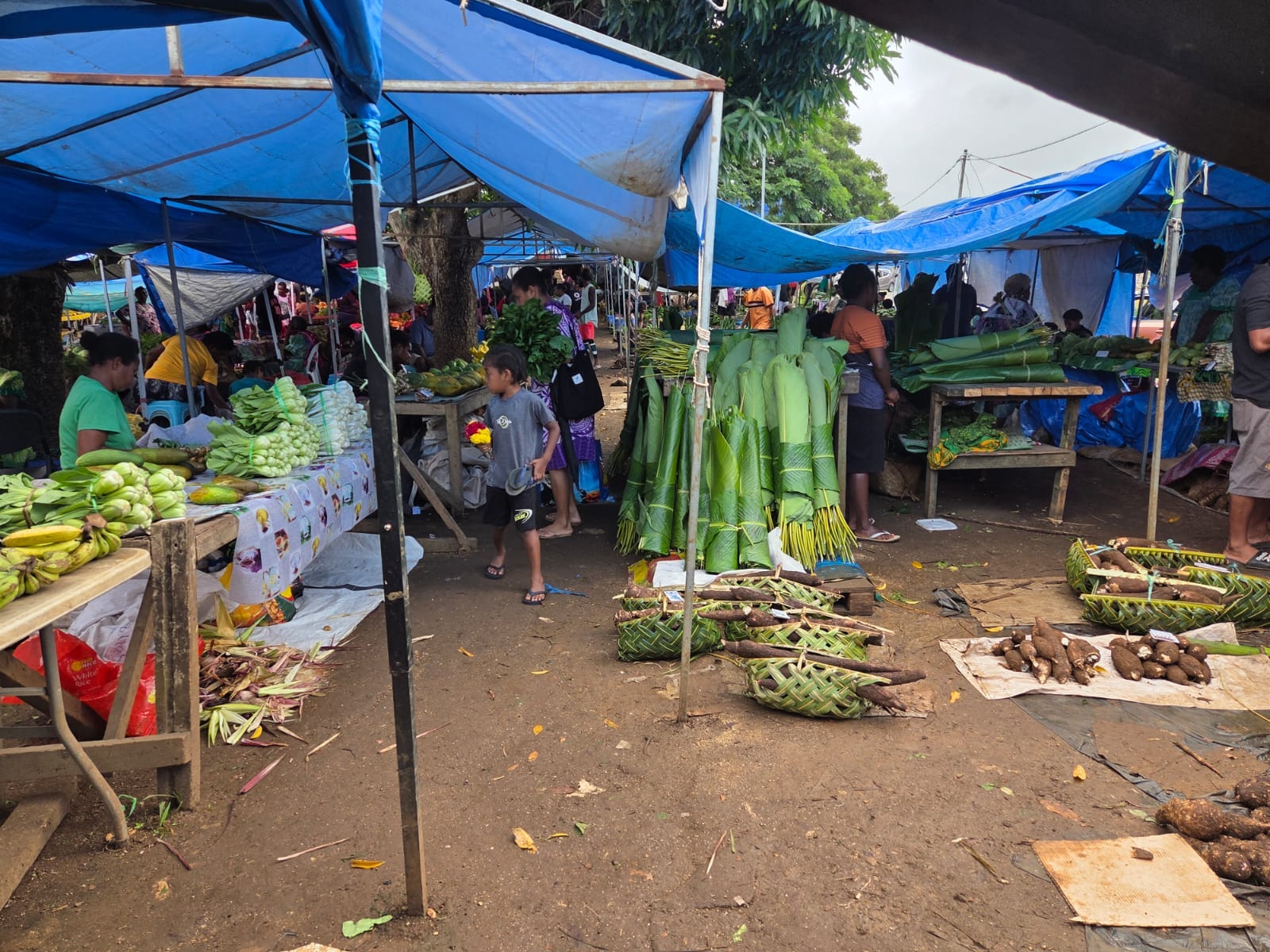
I went to the Banyan Beach Bar, which had an excellent 7 pm fire-dance show.
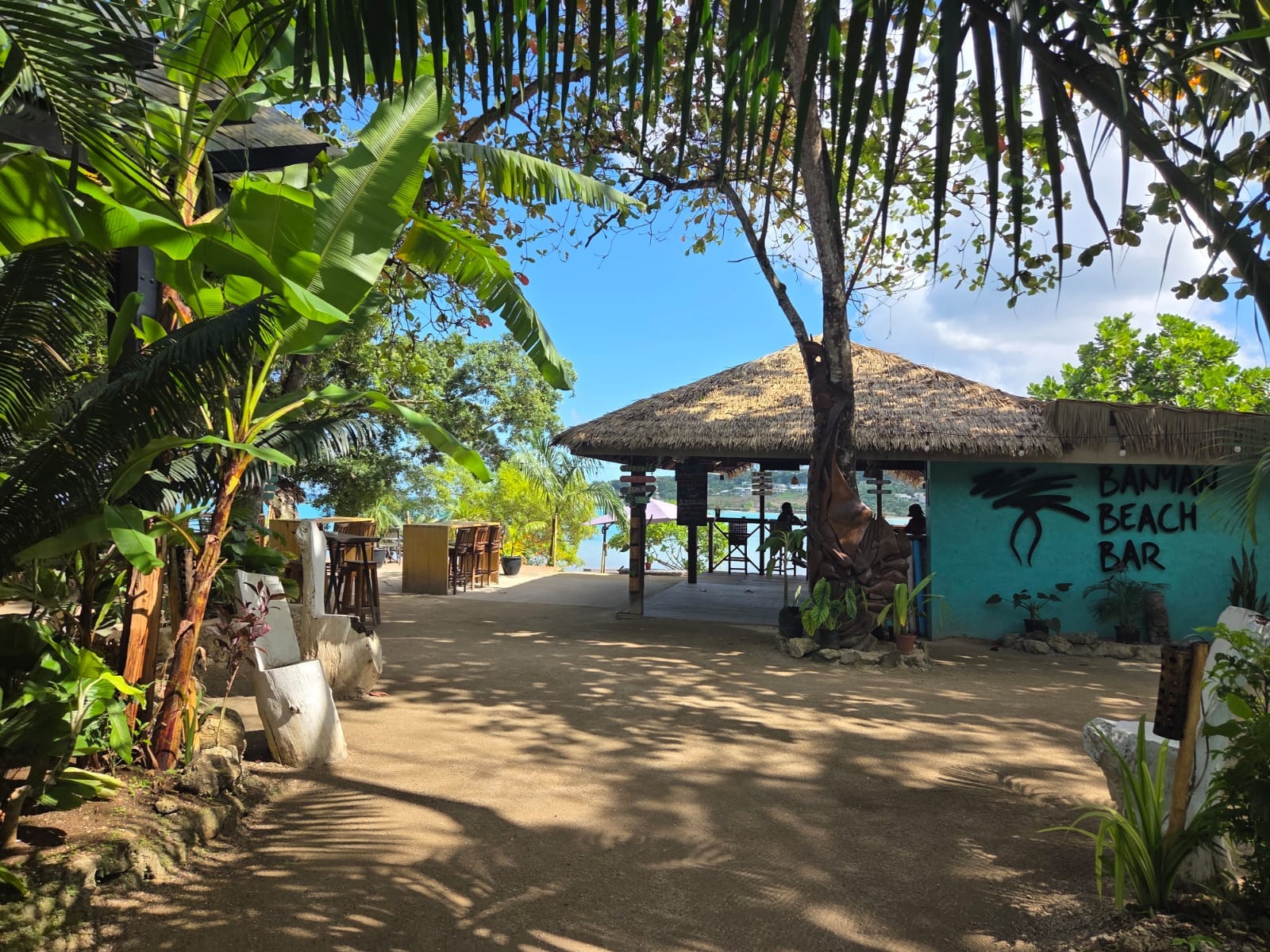
One fire dancer went up and down with rags, like Cirque de Soleil. There was a lovely little 8-year-old kid in the show as well.
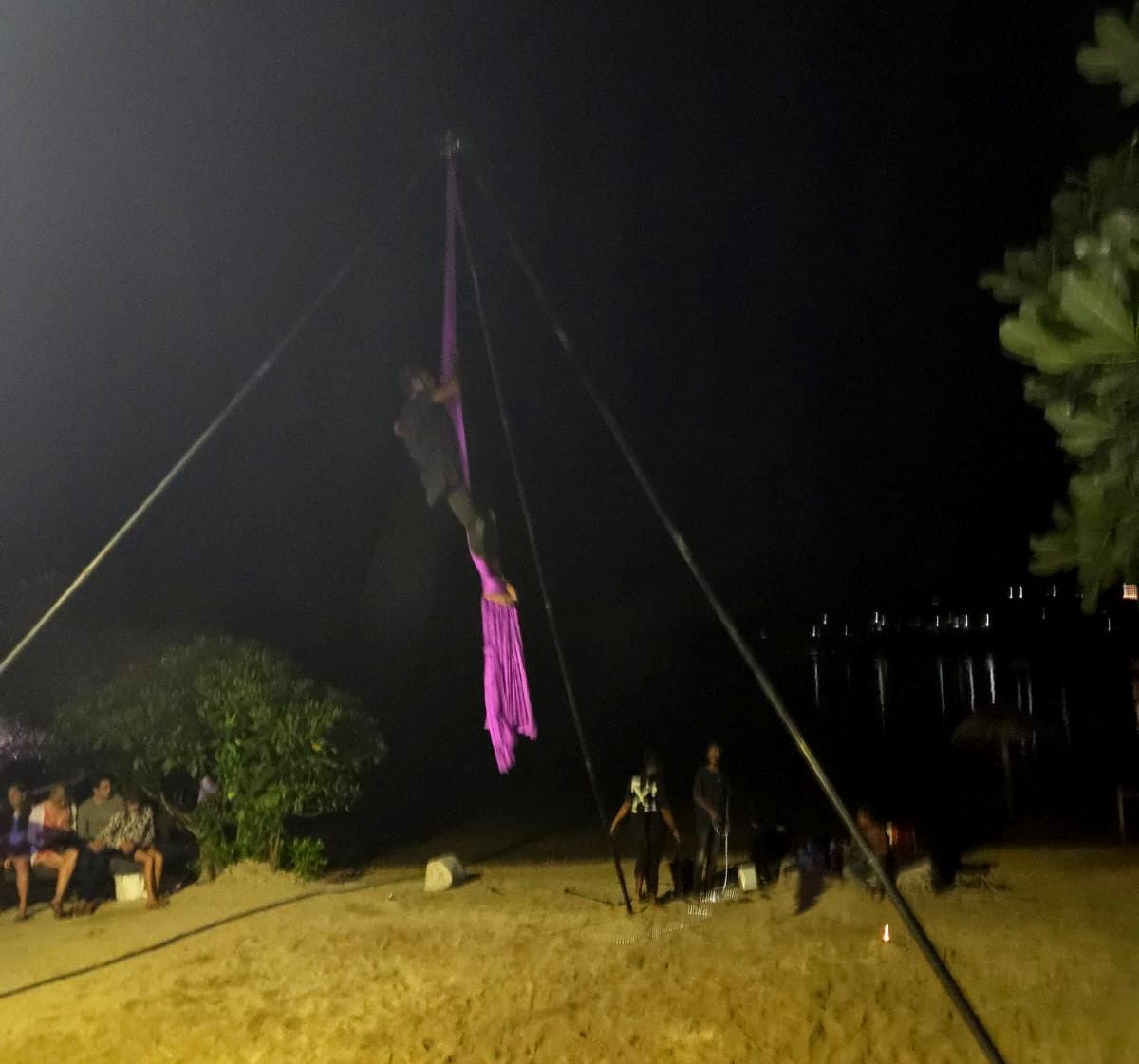
And I found a Chinese dairy called Rorona where I got a beef stir fry for VT 600. You could get whatever you wanted, like sushi, and bread.
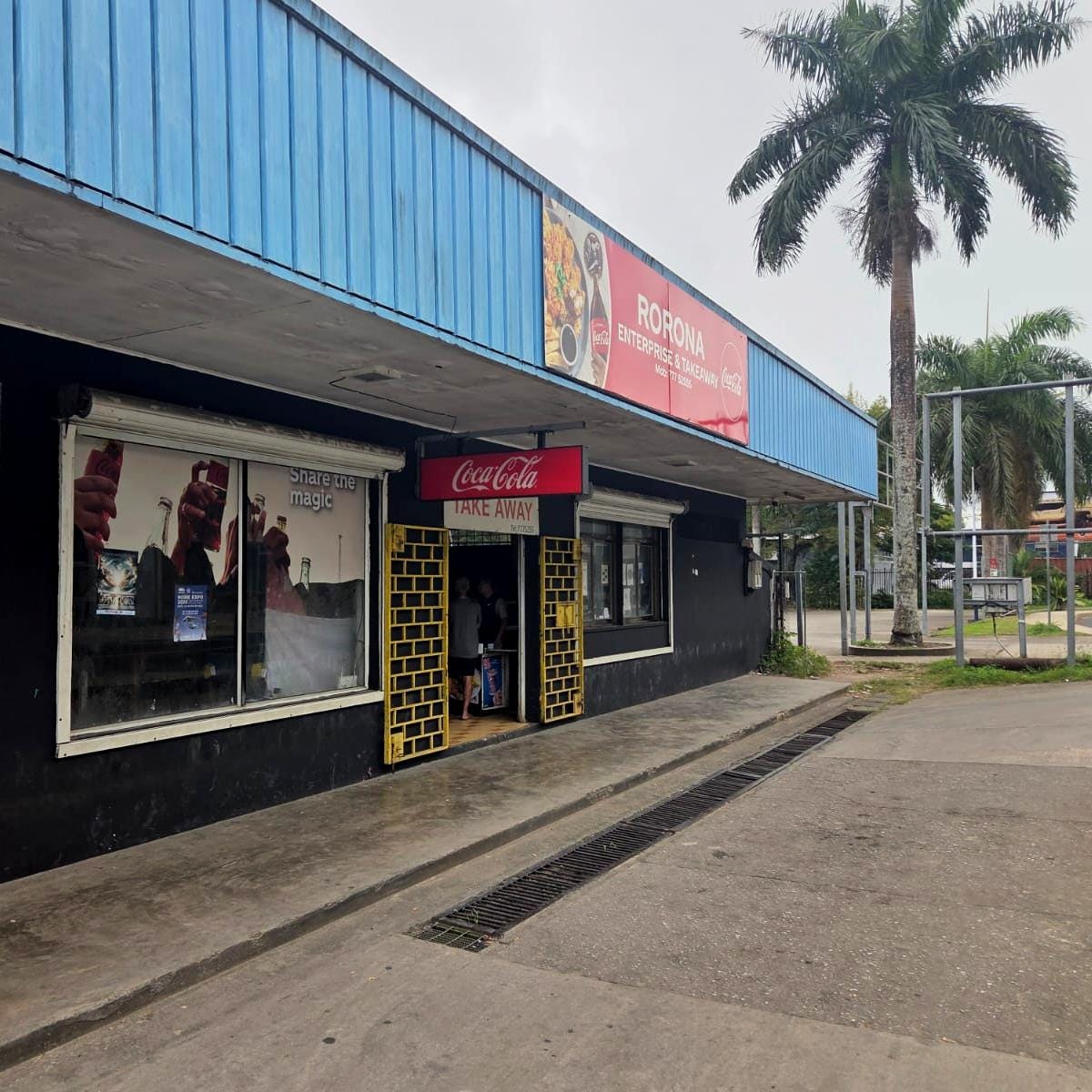
I visited a shopping mall as well. In the shopping mall you could get an array of food from the takeaway places, and there was a movie theatre.
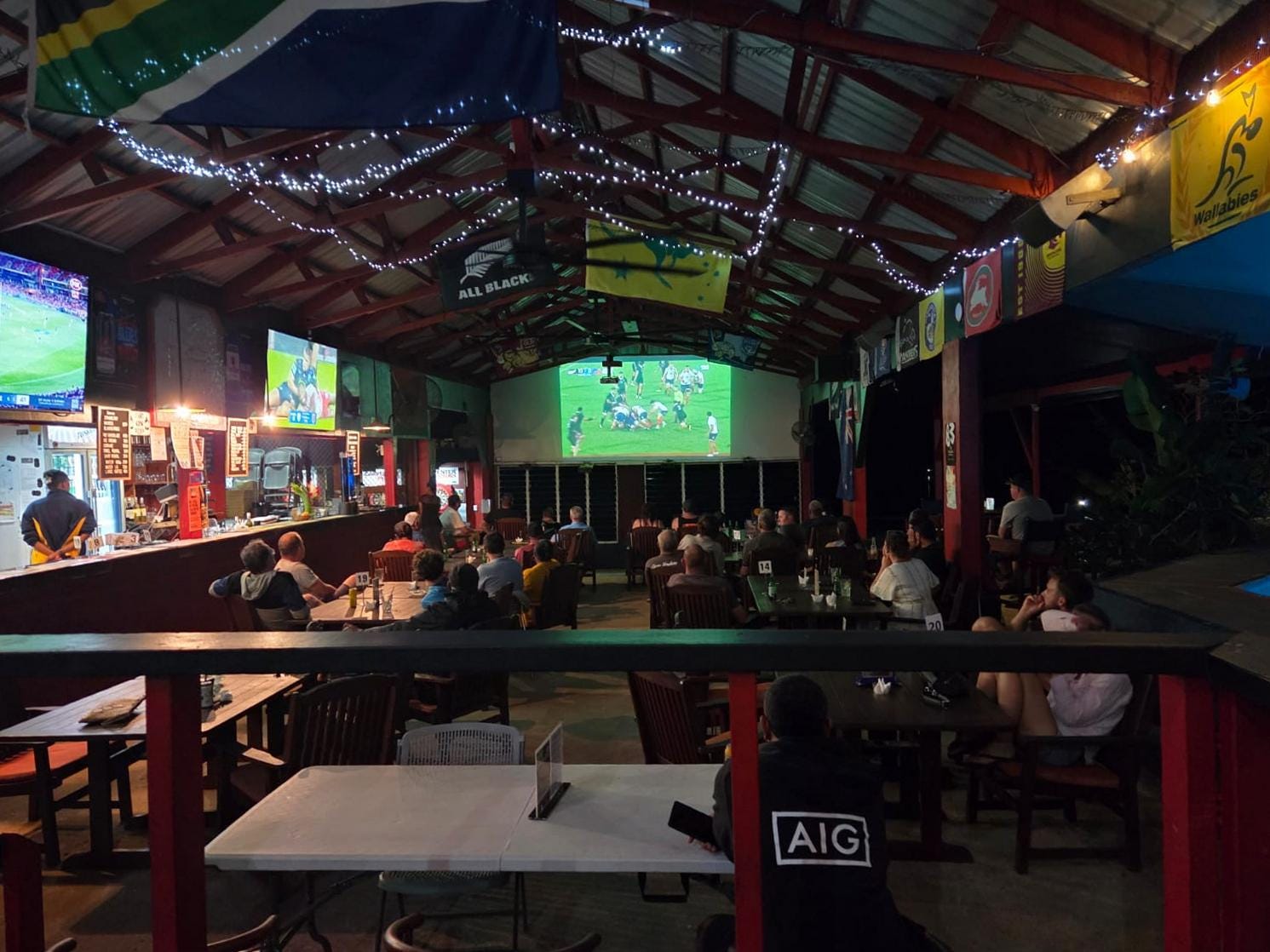
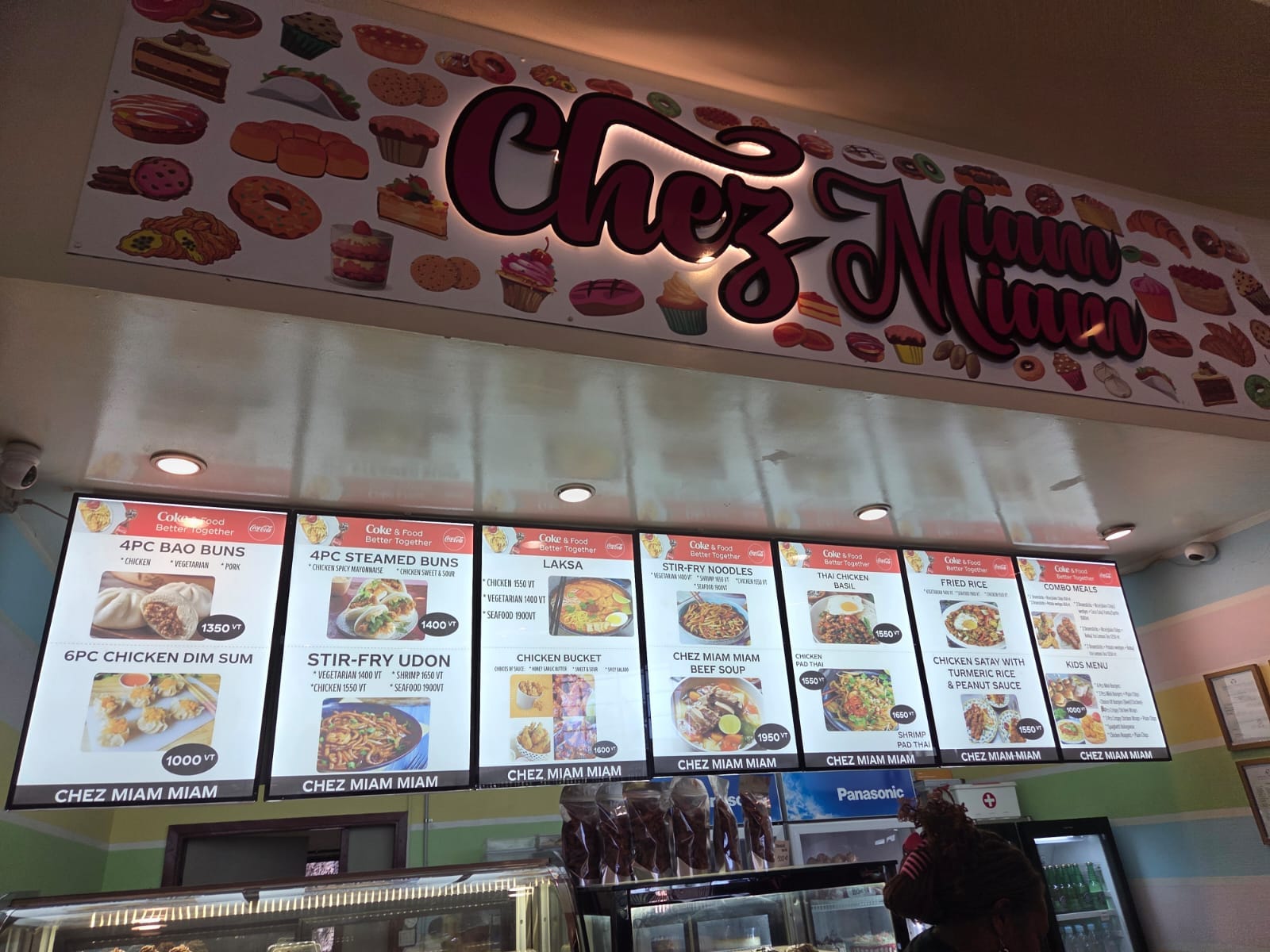
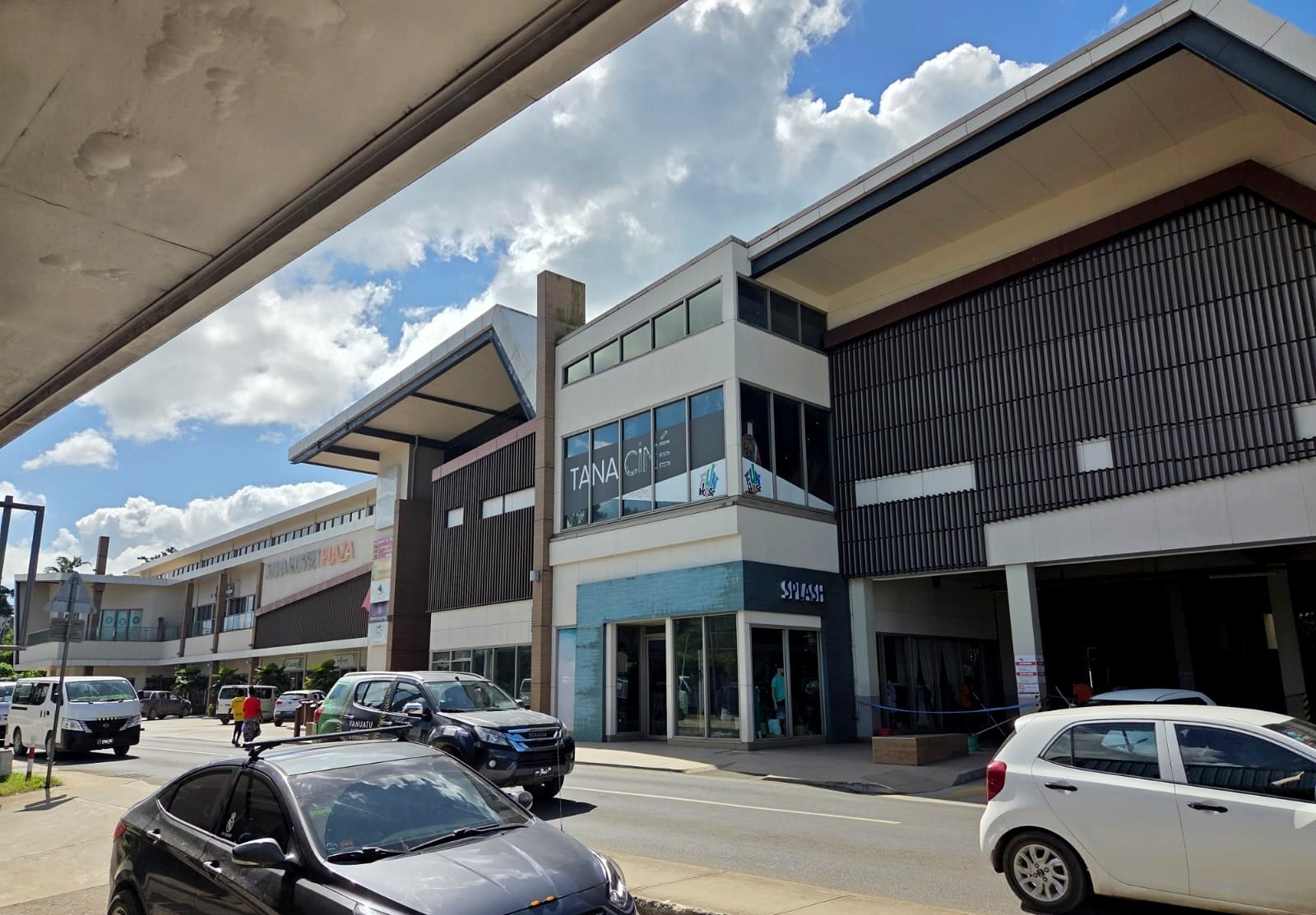
I got photos of a takeaway caravan. There were so many pizza and hamburger places, and red Coca-Cola umbrellas were everywhere.
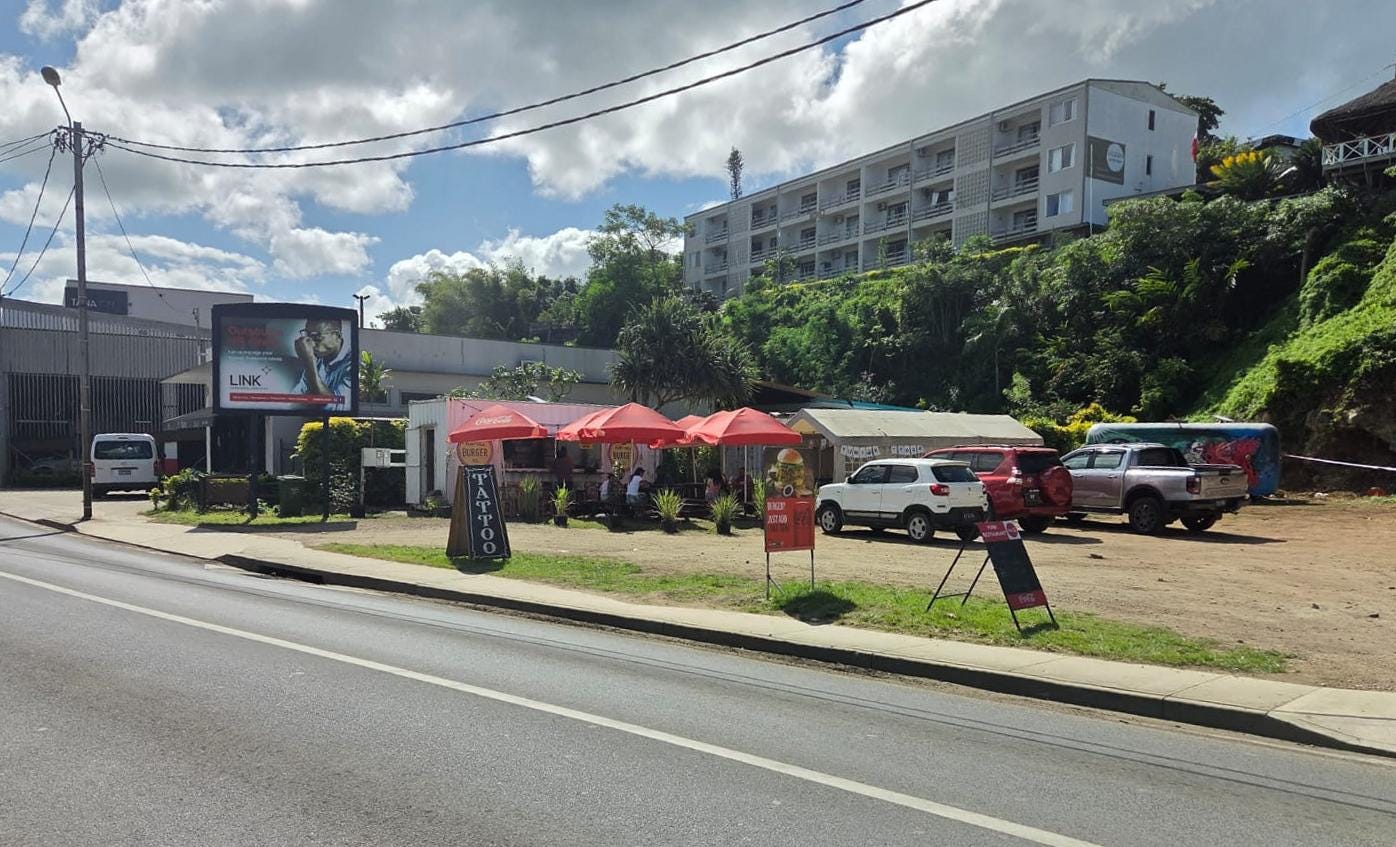
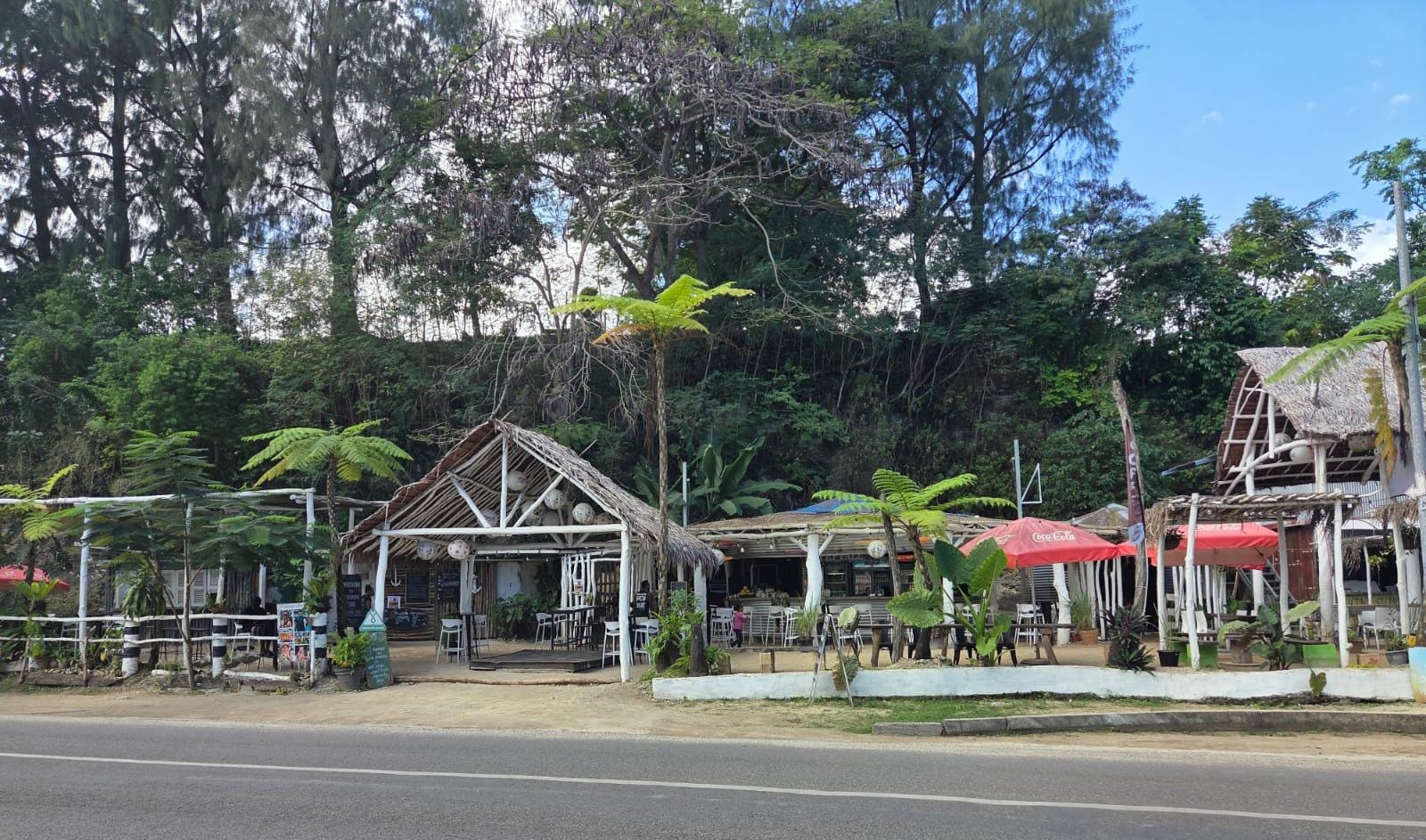
They sell more traditional food at night, such as ceviche (the Latin-American Spanish name for a raw fish salad in which the fish is ‘cooked’ or turned white by acidic citrus juices) and, of course, Vanuatu’s national dish, laplap.
And they eat a lot of pork here. I had some, deep-fried and crumbed.
And bananas fried and soaked in coconut cream, which were only VT 60.
Bluepango was 700 metres from the Breakas Beach Resort, where I had beer for VT 600 or nearly NZ $10. I was able to get the same beer from the dairy for VT 300, but you are paying for the surroundings, as they say.
Surroundings which were certainly amazing at Breakas, infinity pool and all: their website gives you the idea straight away. Of course, you will pay extra to stay there as well.
I had a local fish dish, of snapper and manioc, with a couple I ran into at Breakas: a woman from Brisbane who was celebrating her birthday, and her husband, who had an interesting job as a toolmaker.
The local beer is called Tusker, or Vanuatu Tusker, which has an image of a boar with formidable tusks on the bottle. I’m not sure whether it is the same as the better-known Tusker from Kenya, which has a bull elephant on the bottle. I had Vanuatu Tusker Lemon, which was lovely. They also distil their own spirits here.
I visited the Ekasup Cultural Village as well.
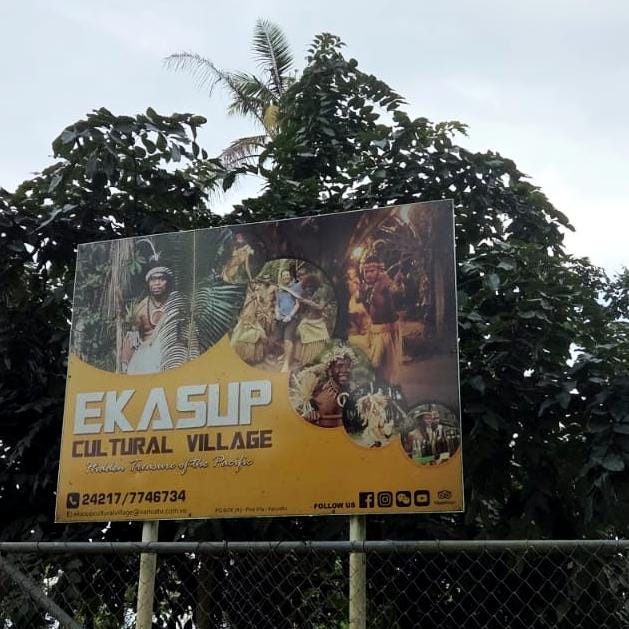
The blurb from the Vanuatu Tourism Office, as of 18 July 2025, says that:
The trip relate tales of cannibalism in the not so distant past , the primitive but effective spears and other methods & techniques for trapping wild life’s including pigs, chicken and fish . If it is suspected that some fish maybe poisonous, Ni Vanuatu will demonstrate a sample on the ground; if ants avoid it, it’s poison however if ants eat it so do the people.
Not the Disney version, in other words.
I also tried snorkelling. It is beautiful around here, really nice and relaxing; and there is a World War II plane that you can dive and have a look at.
Here are a couple more images from the local nature.
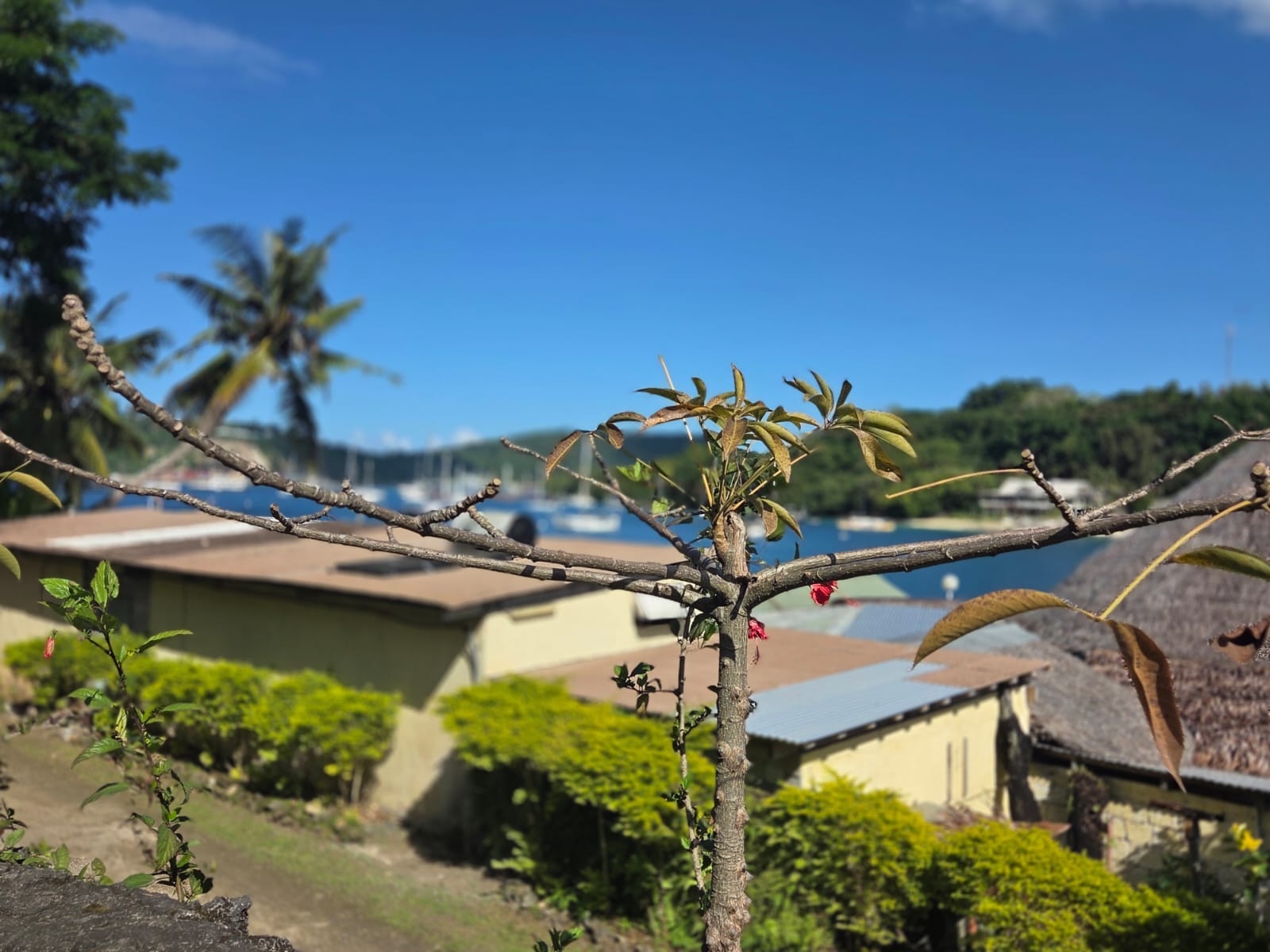
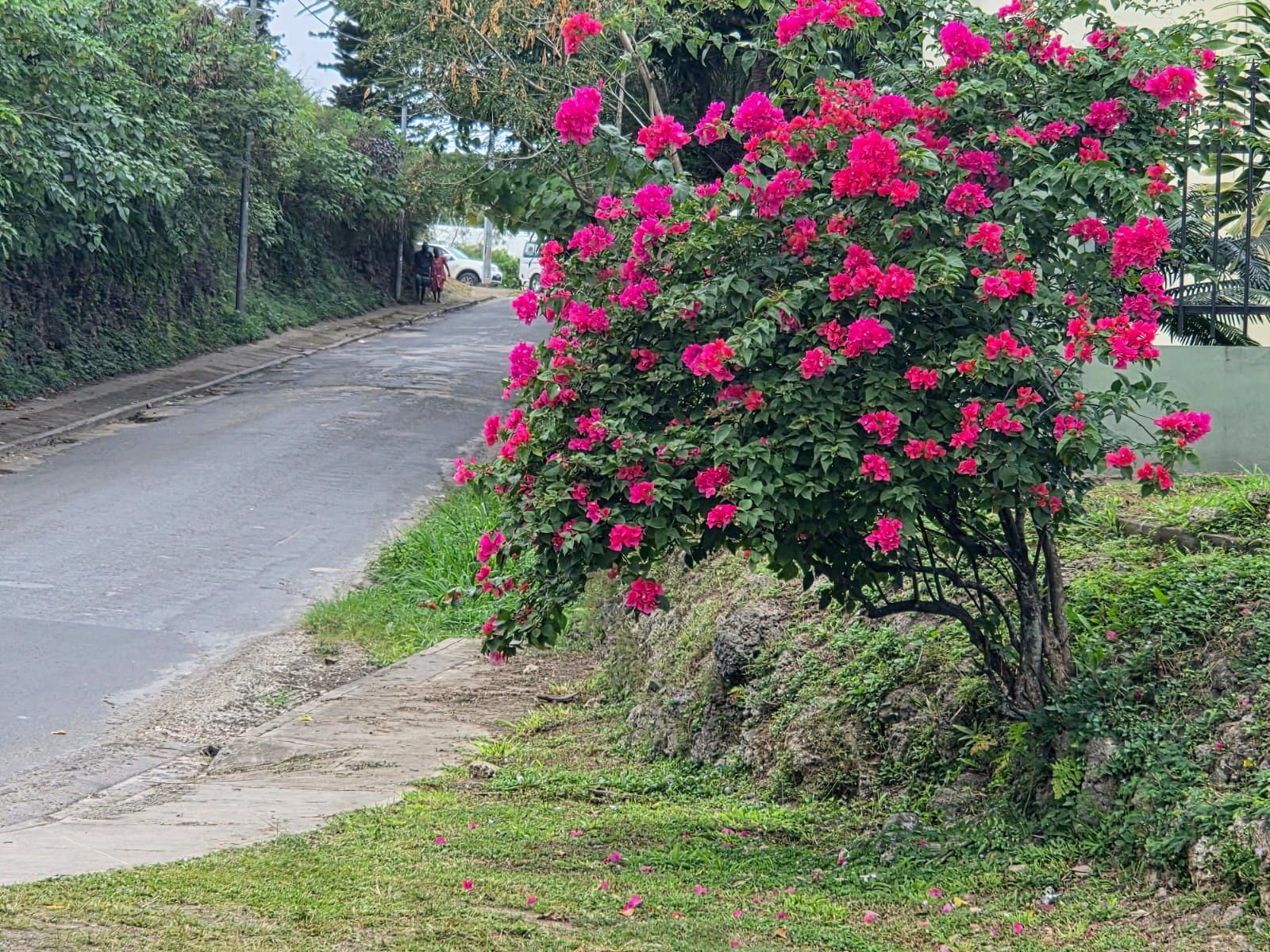
My first two places were found on Booking dot com. The third plance where I am going to stay is at I am staying at is Hideaway Island, through Airbnb. And my fourth is at Port Havannah, also through Airbnb, which is further north.
I’ve organised a tour around the island for tomorrow. A lot of the people driving vans are RSC workers, Vanuatuan guest workers who have spent time in New Zealand and Australia.
There was a play about RSE (Recognised Seasonal Employer) workers which I tried to get to, called Wan Briks Haos, or ‘One Bricks House’ I think, maybe a reference to an RSE worker paying to get a house built at home. It looks extremely funny.
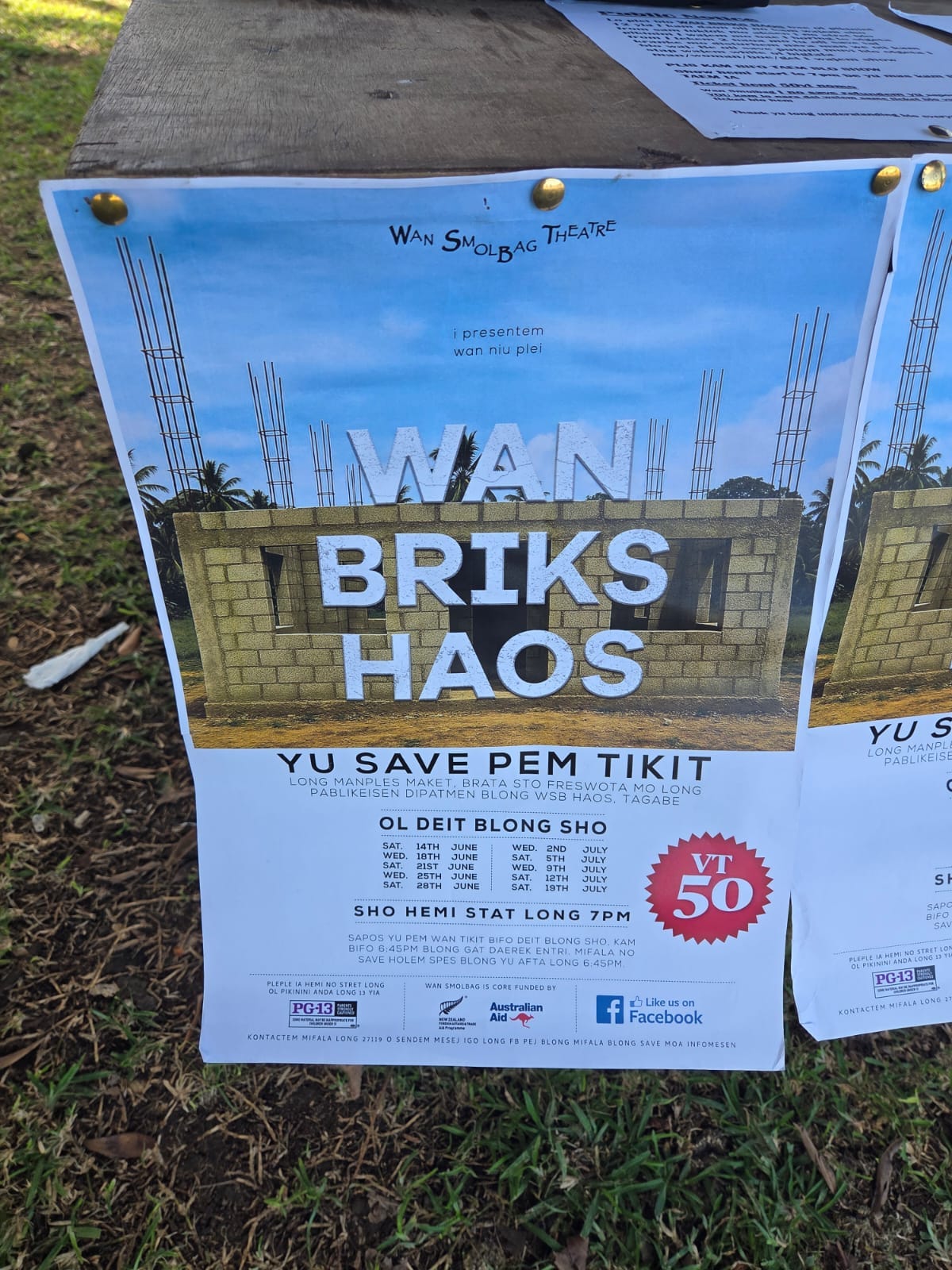
People here are very theatrical. Wan Briks Haos was put on by the Wan Smolbag Theatre (‘One Small Bag Theatre’), a local Bislama-language theatre which you can also read about here, and view its YouTube channel here.
The fact that, save for Wan Smolbag’s channel, there must be just about nothing in Bislama on social media and Netflix, etc, surely works wonders for the local theatrical industry. Long may it remain so!
RSE workers seem to have enjoyed their time in NZ more than in Australia. In fact, Ni-Vanuatu and other Melanesians used to be kidnapped and enslaved in colonial Australia — mainly in Queensland — to do the same sorts of rural-labouring jobs that RSE workers do today, a practice called blackbirding and which we would today call human trafficking.
The practice was illegal, like human trafficking today, because the policy of the British Empire at the time (of which Australia was supposedly a part) was to try and stamp out slavery.
Here is an engraving of trafficked Melanesians, bound for Queensland, being freed by the crew of a Royal Navy ship, HMS Rosario, in 1869.
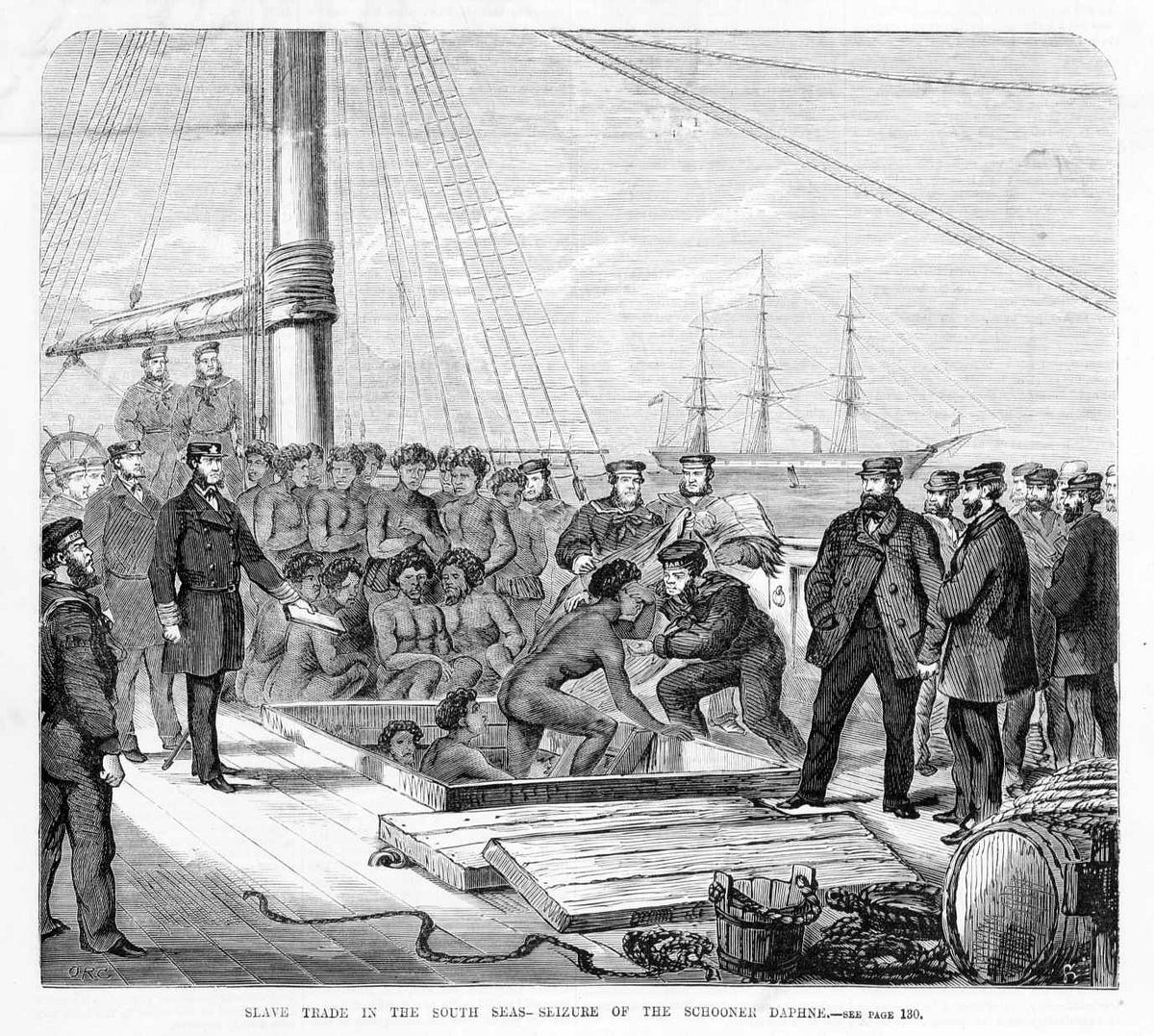
The Bislama language, and related creoles such as New Guinea’s Tok Pisin, evolved on the illegal slave plantations as a way for Melanesians, who all spoke numerous different local languages, to communicate with each other and their enslavers, in ways that began as pidjin English but soon turned into proper languages once they were brought back home by liberated ex-slaves.
So, being an RSE worker in Australia might be a bit too much like a blast from the past.
Anyhow, these days, whether in New Zealand or Australia, the RSE workers earn money to buy vans and then drive the vans for tourists back home in Vanuatu.
For a woman, wearing a dress is more respectable and less likely to result in harassment than shorts.
Chief George said that Melanesian society is very patriarchal; not at all like Polynesian culture in that respect.
I also noticed that quite a few of the coconut trees had died. This is the result of the invasion of parts of Vanuatu, Efate above all, by the coconut rhinoceros beetle, an unwanted import from South-East Asia that hitched a ride on ships coming into Port Vila.
The same beetle has also turned its attention of late to corn plantations, as if, having finished off many of Efate’s coconut trees, it is now after a second course.
This is another big problem the locals face, to add to the natural disasters and tourism slump. Scientists are trying to come up with a solution.
A pastor from Nigeria who is staying at my hotel, and who has been in Vanuatu for two years, said that the customs in Vanuatu were identical to those in his part of Nigeria (though the food is not), and that some of his friends in Vanuatu wanted to connect with what might be ancient cultural roots in Africa, however long ago that was.
Lastly, for everything I have missed, a Guide to Port Vila and Efate can be found on the website of the Vanuatu Tourism Office (vanuatu.travel).
Next week, I will blog about my tours outside Port Vila.
Subscribe to our mailing list to receive free giveaways!